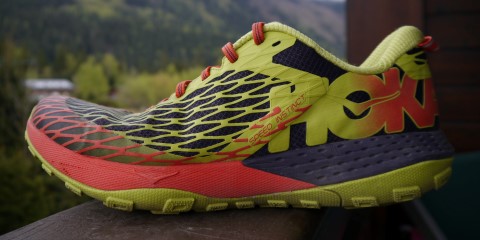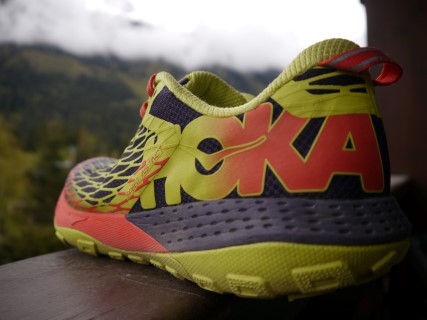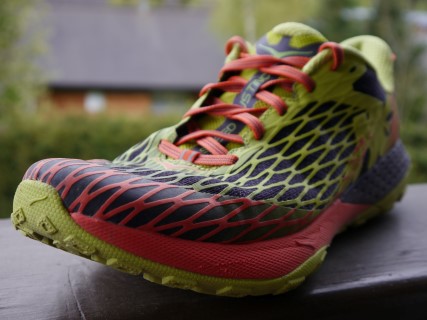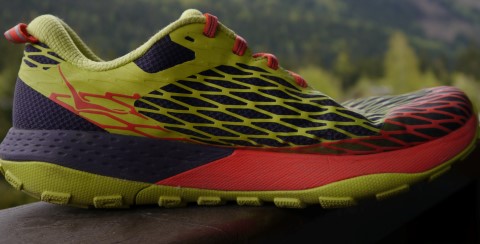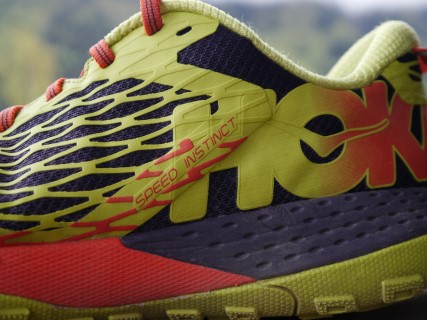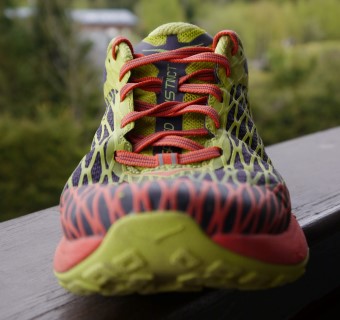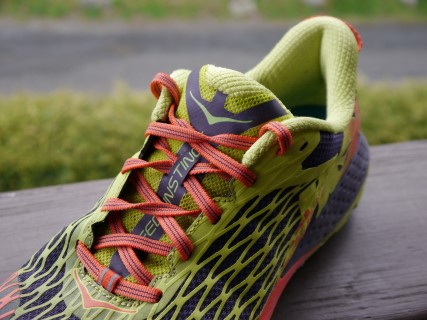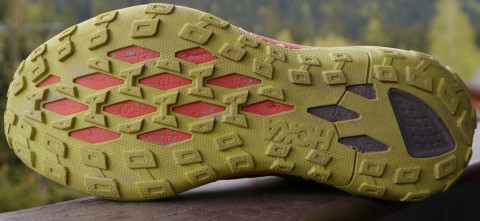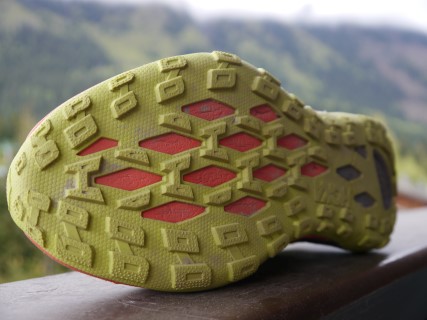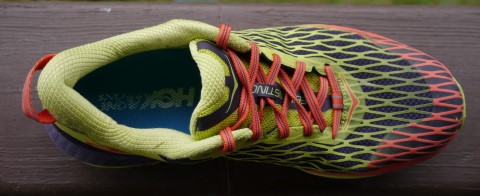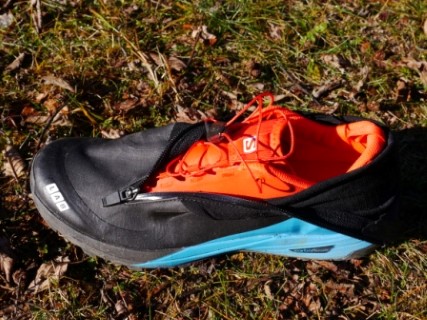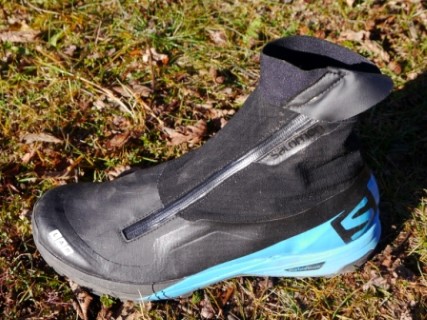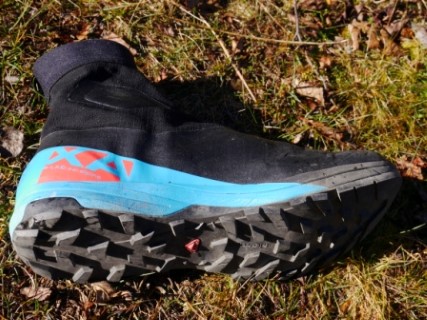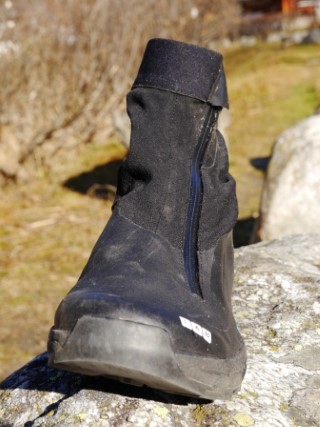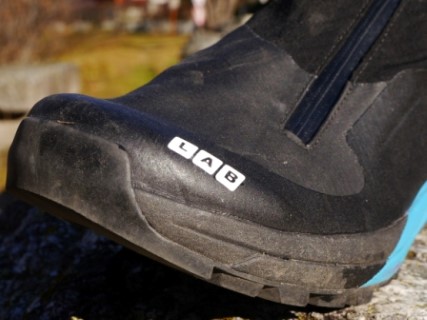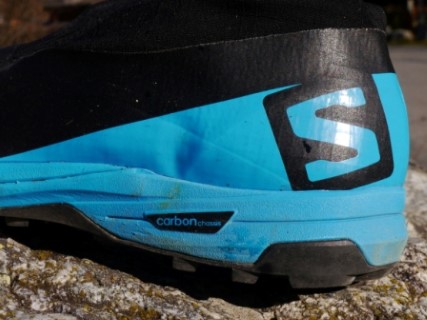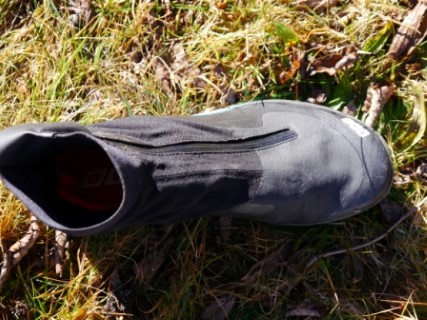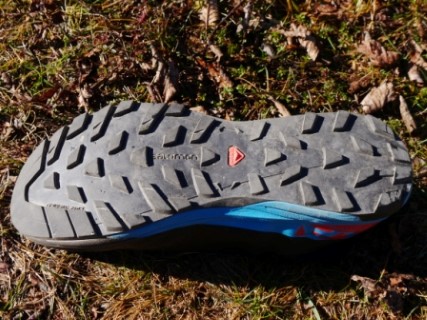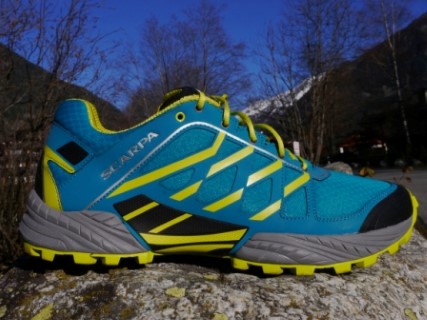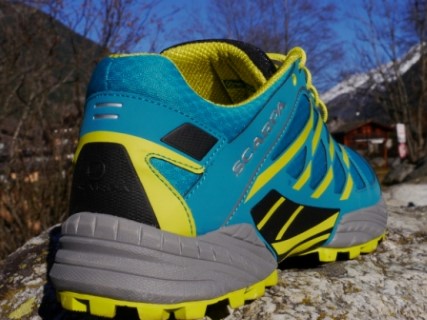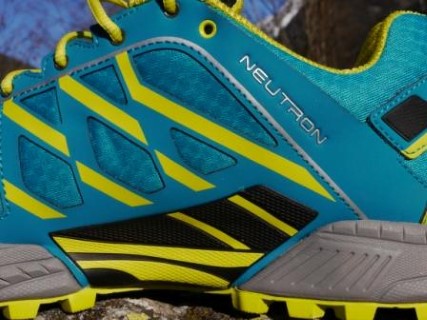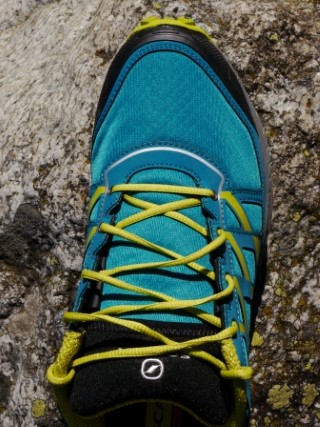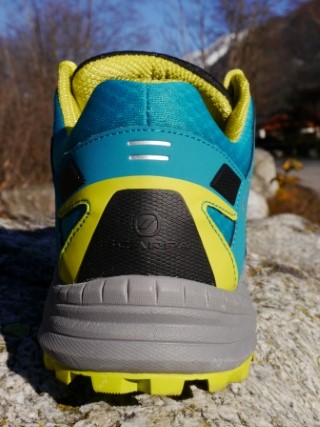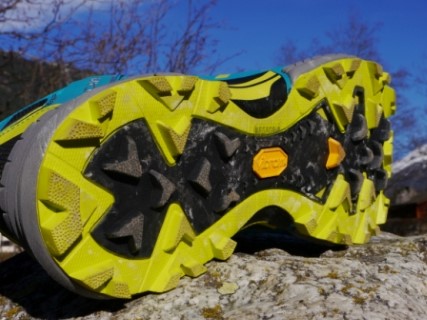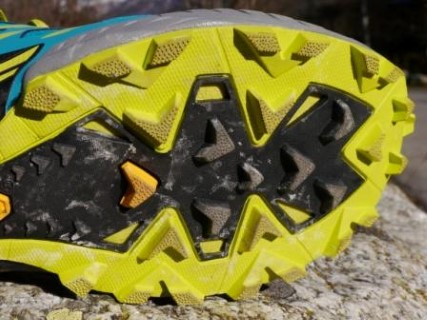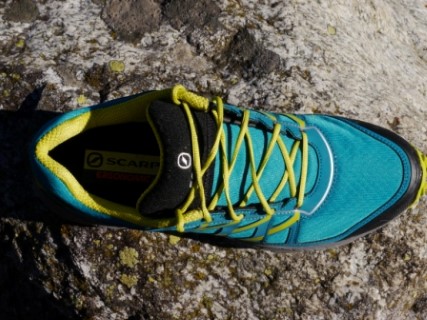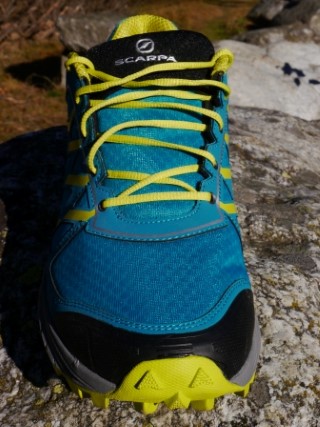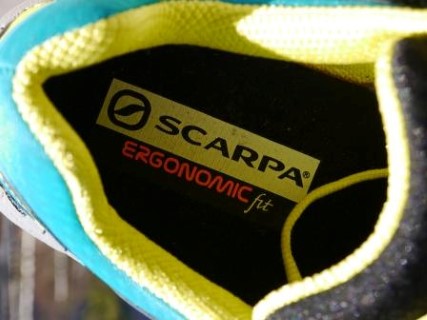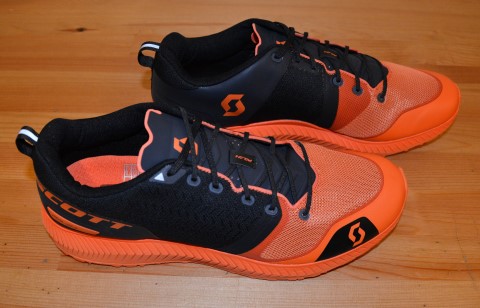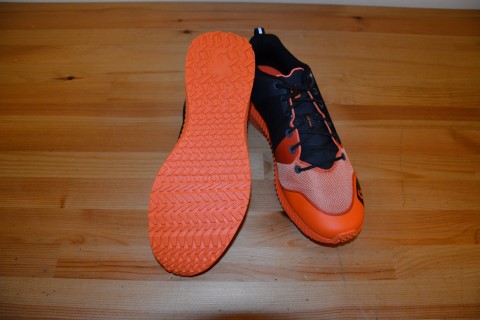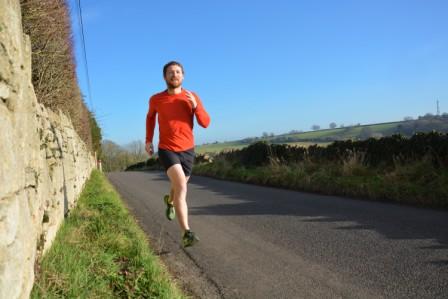Written by Neil Bryant for the URC
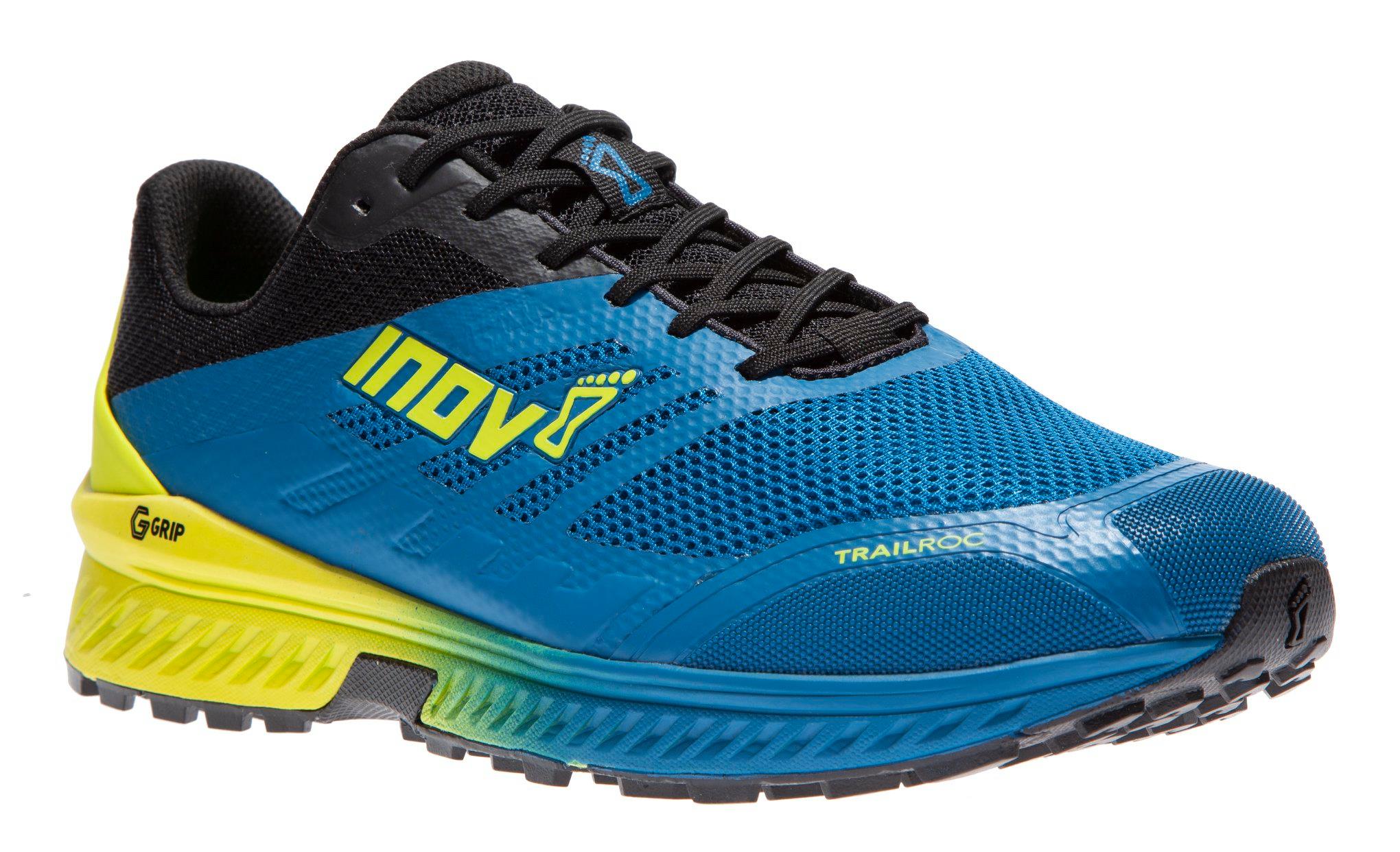
Along with the Race Ultra Pro 2in1 vest, I received the brand new Trailroc G 280 shoes from inov-8 as free samples to run into the ground and review. The shoes take more time to properly test, so after 388km on pretty much all terrain, mostly here in the Chamonix valley, but also on a trip to Scotland running all around the Ben Nevis area, I now feel ready to offer my opinion.
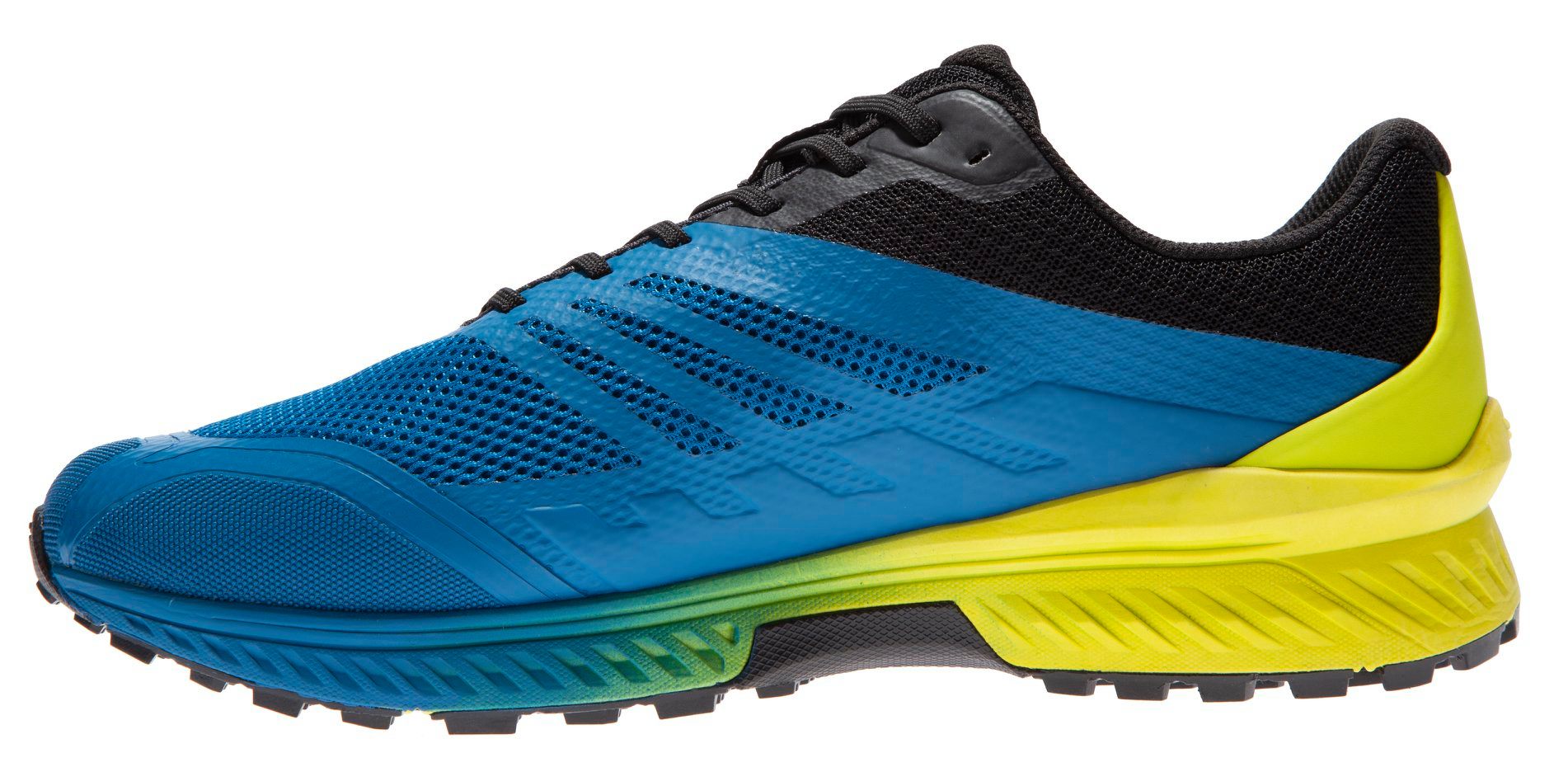
On paper, I had high hopes, as they have a rather larger than my preferred heel-to-toe drop at 8mm (my achilles had been a little sore lately so this was a good thing), increased protection around the sole and the toes, and they have the new, massively publicised Graphene sole. Overall a shoe designed for longer days in the mountains. The sole is fairly minimal with the stud depth being just 4mm, so it is certainly not meant for sloppy, deep mud. More for wet or dry hard pack trail. Basically, they are ideal for the Chamonix valley as there are not too many places where it gets very muddy even with heavy rainfall as it drains so fast in most places.
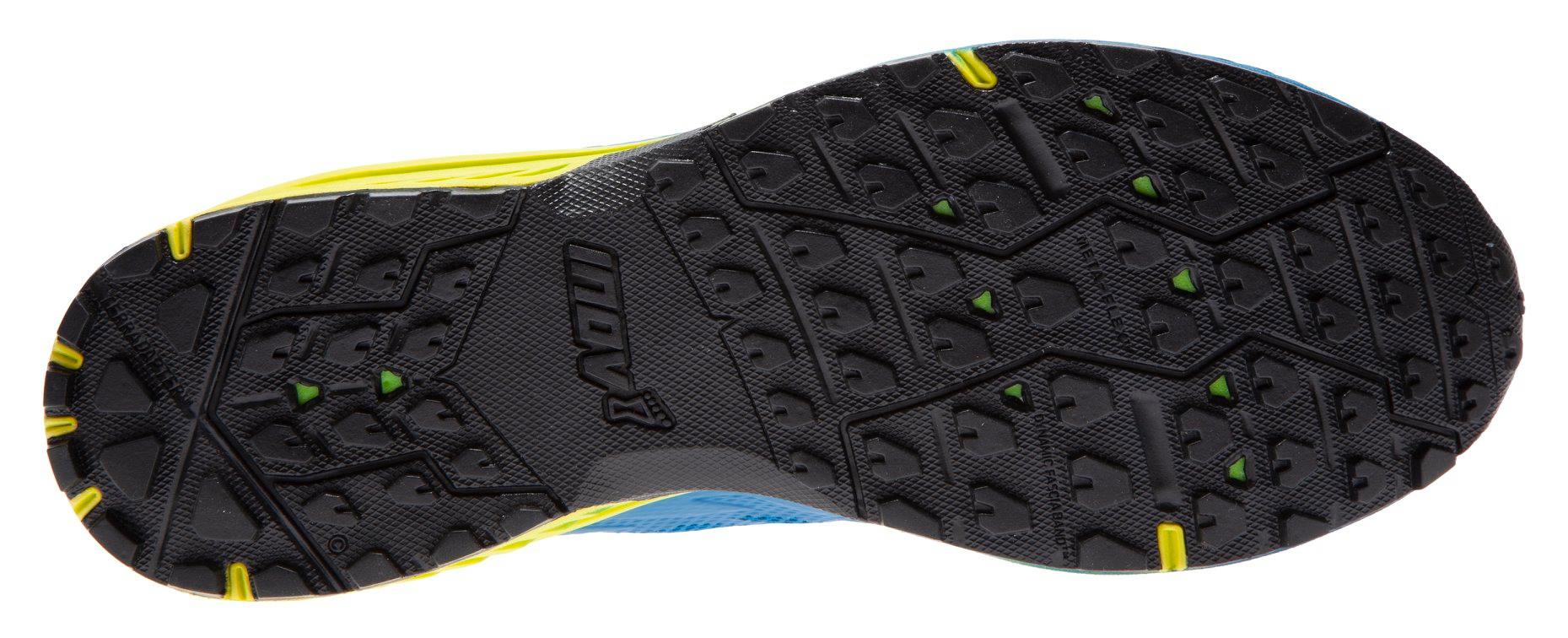
It is a size 3 width according to their own system (between 1-5, where 1 is the narrowest), so is not a narrow fit. This is also good for me as generally the narrower shoes are just too tight for me, so I have to get the next size up and tighten them more.
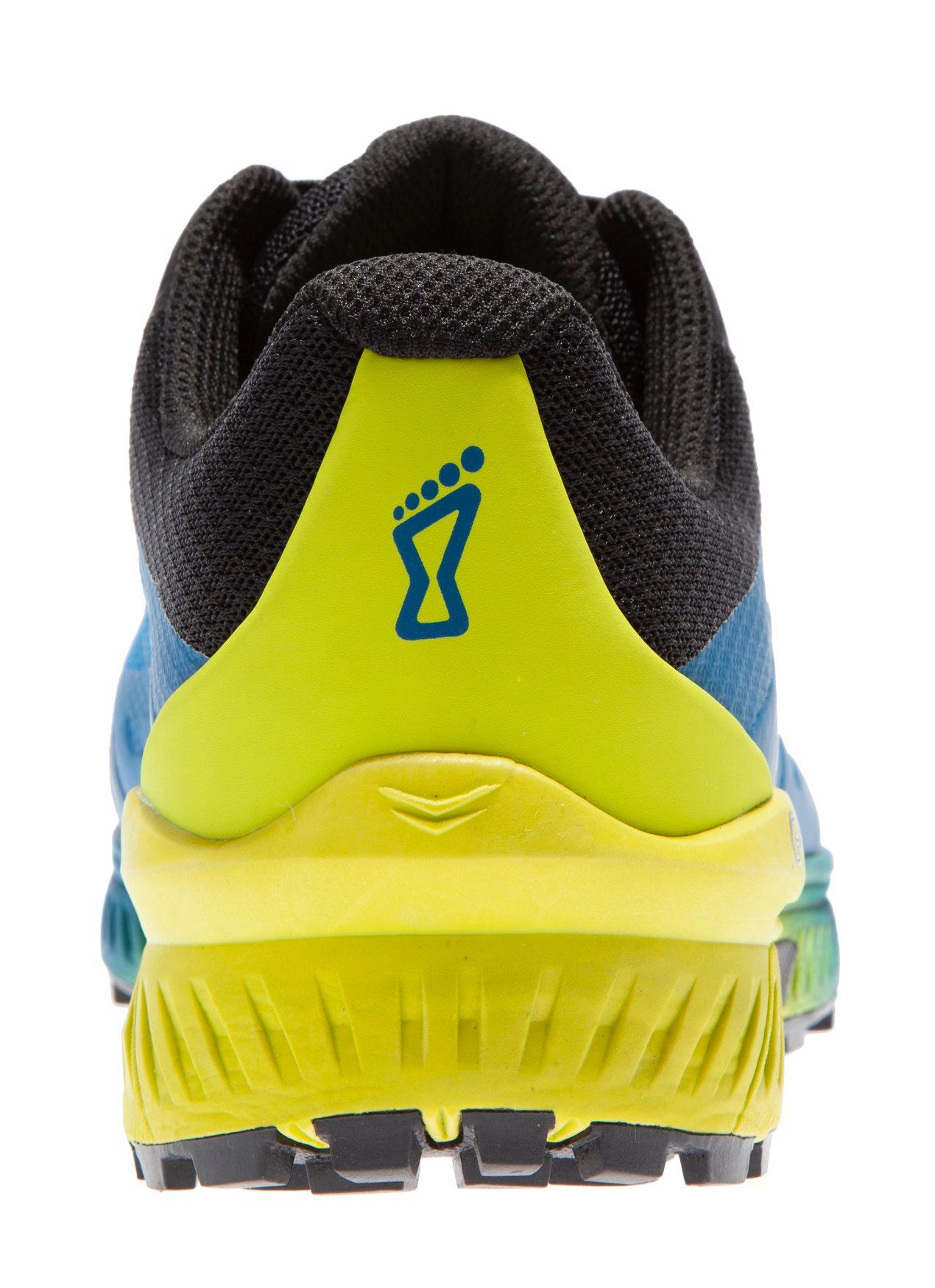
I slipped them on and was instantly remined of the Terraclaw 250 which I had tested a few years ago. The terraclaw is quite a different shoe, but the fit and feel of the shoe felt the same. It felt wide on my foot. Was it too much and would my foot slide around on off-camber terrain? I didn’t like the thin flat laces. They curl up and make them a bit fiddly. The toe felt good and solid, the 280g weight, although far from fly weight, are plenty light enough for me. Weight sacrifices have obviously been made for extra cushioning, toe protection and padding in the upper. The graphene grip felt tacky on my tiled floor at home. How will they cope on the trail?
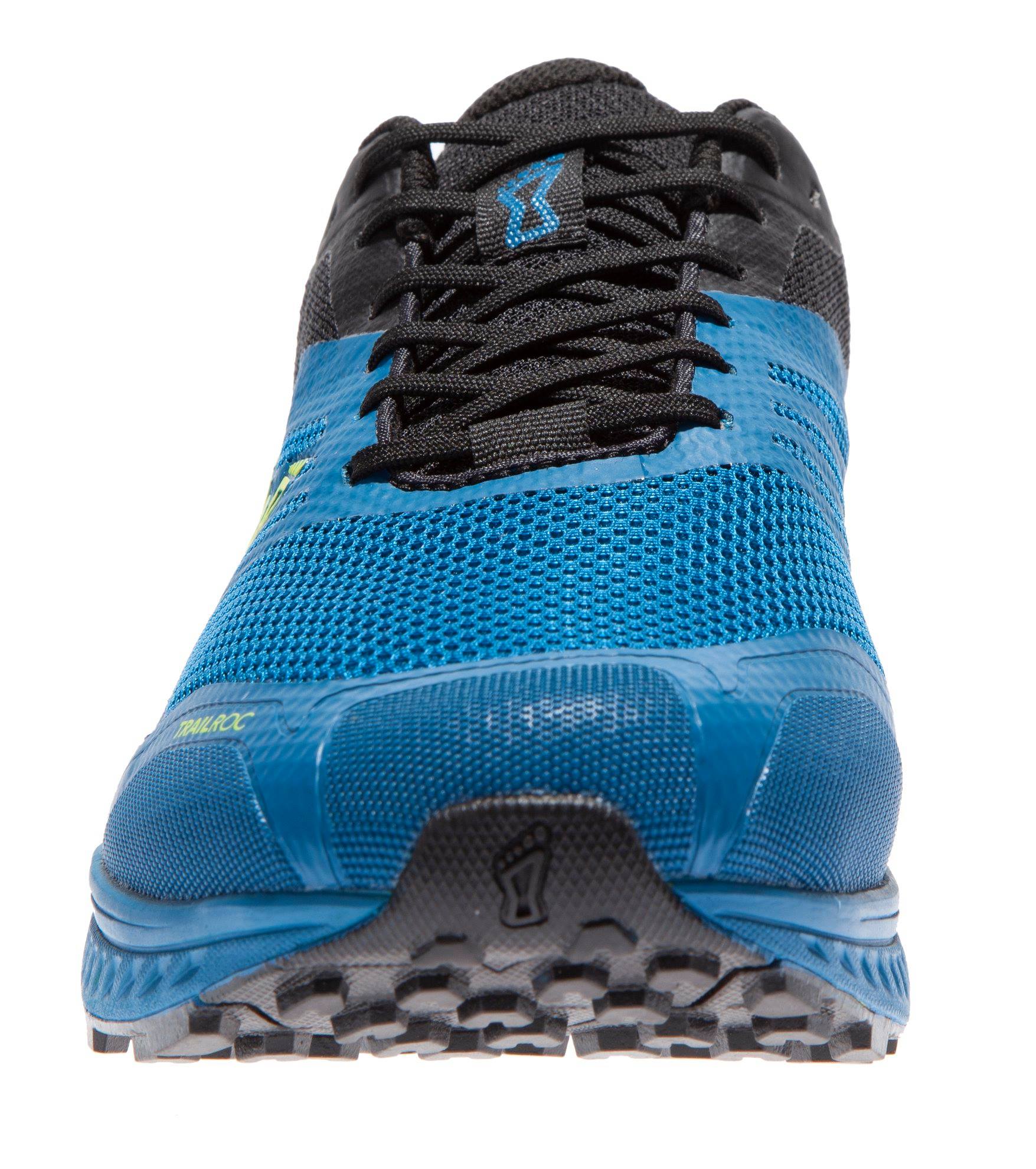
As mentioned, they have almost exclusively been tested in the Chamonix valley plus five days in the Scottish hills. They have seen pretty much all conditions in this time as the hot Summer turned to Autumn, and then suddenly we were in Winter. From baked dry trail to Slippery wet trails and now to ice and snow. They have also seen their fair share of slippery sloppy mud. I know, that the harsher conditions are not what they have been designed for, but I like to test them in everything I can as I know that it is useful to know where they excel and just importantly where they bomb, if anywhere.
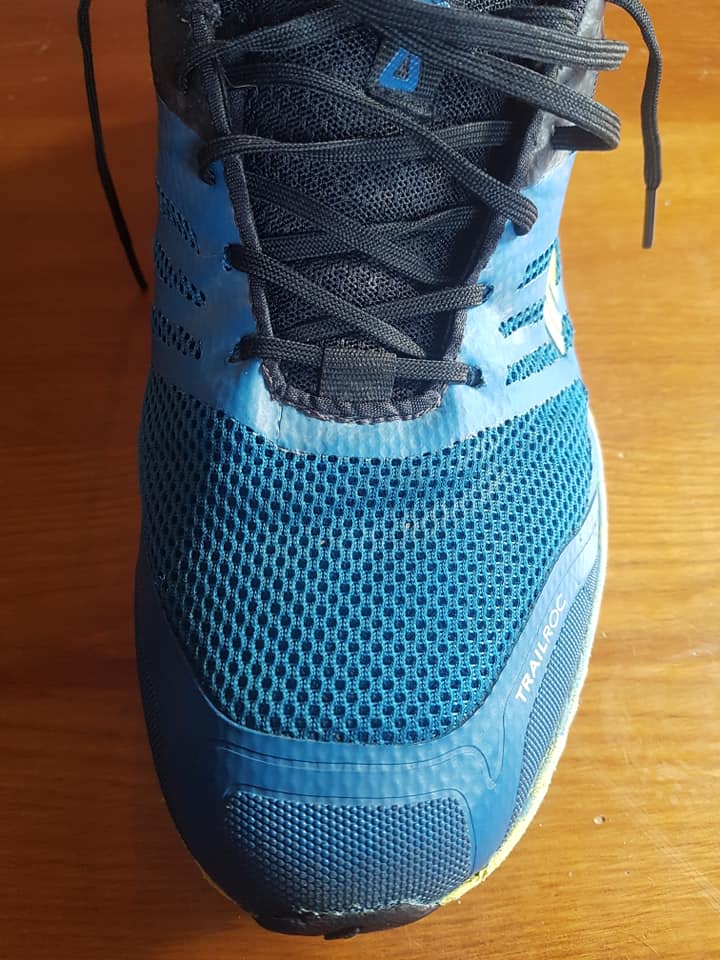
The first image of the shoes today at 388km. The upper is in pretty much perfect condition minus the smell!
The fit and comfort has been exceptional on my feet. The toe box is spacious, more than usual. That combined with the extra toe protection has certainly left my toes in a better state than normal which is really nice.
They feel slipper like and my concerns about my foot slipping about have been unfounded, though one of the insoles has slipped back so my toes overhang at the front which is annoying. It doesn’t seem to have given me any actual problems though. I obviously slide it forwards every time I put them on but it soon slides back again. I would glue it down but like to remove them after each run to let them air out.
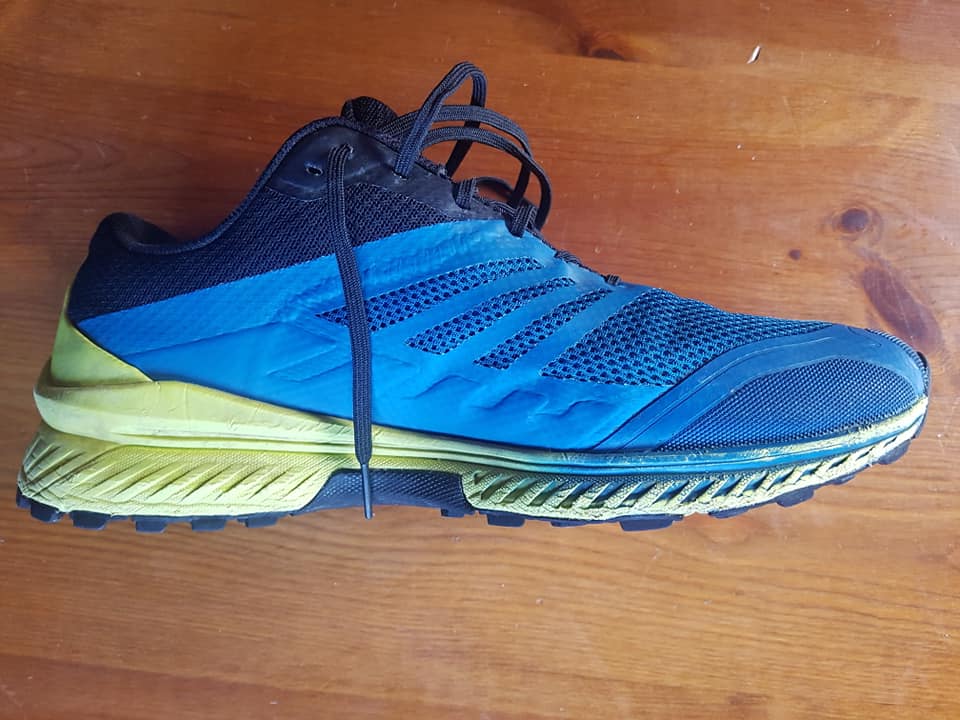
The side image here again shows the upper, and also the more battered midsole
The extra cushioning is great. It still isn’t loads and, in my opinion leaves you plenty of trail feel which is nice, but sharp rocks are no longer a thing to be feared! The upper is well vented so they are great in the heat and also drain really well when wet. I did a few river crossings and plenty sinking in boggy ground, and they really seemed to drain well.
One thing I’d like to note is the midsole protection over the time I have been using them. I am sure that over time, the protection has lowered quite noticeably. I realise that the midsole will break down and lose its shock absorbing and energy return qualities over time, it just feels like this has been a lot quicker than normal. As it is, they are even more slipper like and there is more trail feel, but for me it is still ok, but, if it progress’s, then it could get a bit painful.
The minimalist tread also lends itself well to road running too, which I have done a little of on my quest to gain some speed.
Then there is the tread. Is this Graphene all inov-8 have built it up to be? Can a tread be grippier and more durable than anything else out there? It all sounds a little too good to be true...
Nearly 400km and counting (I have worn this shoe exclusively since I got them) and I have to say that the Graphene is really good! On the surface this shoe is designed for, it is superb. It sticks to dry rock well. It reminds me of the La SportivaKaptiva tread in that it feels sticky, almost like a climbing shoe. In dry, dusty hard packed trail is where it certainly excels. Add a little moisture to the hard packedtrail and it is still pretty tacky. A wet slippery rock is one of the slipperiest things on a trail and it does well. It will slip, but as soon as you know it’s limits you can really push it. I found myself trusting and therefore putting more weight on the foot if I stood on a smooth wet rock. So, how does it fare in terrain it is not designed for? Well, unsurprisingly, deep mud provides issues. Whatever the tread is made of, if it has a relatively shallow tread like it does, then it is going to slip around, and slip around it does! Just recently I descended a very long, wet and muddy trail. It was steep and I didn’t really have any control. Stopping and turning were difficult! It also is not great in the snow, but that again is a lack of deep studs. I guess for me to really understand the effectiveness of Graphene, then a deep tread would be interesting to try.
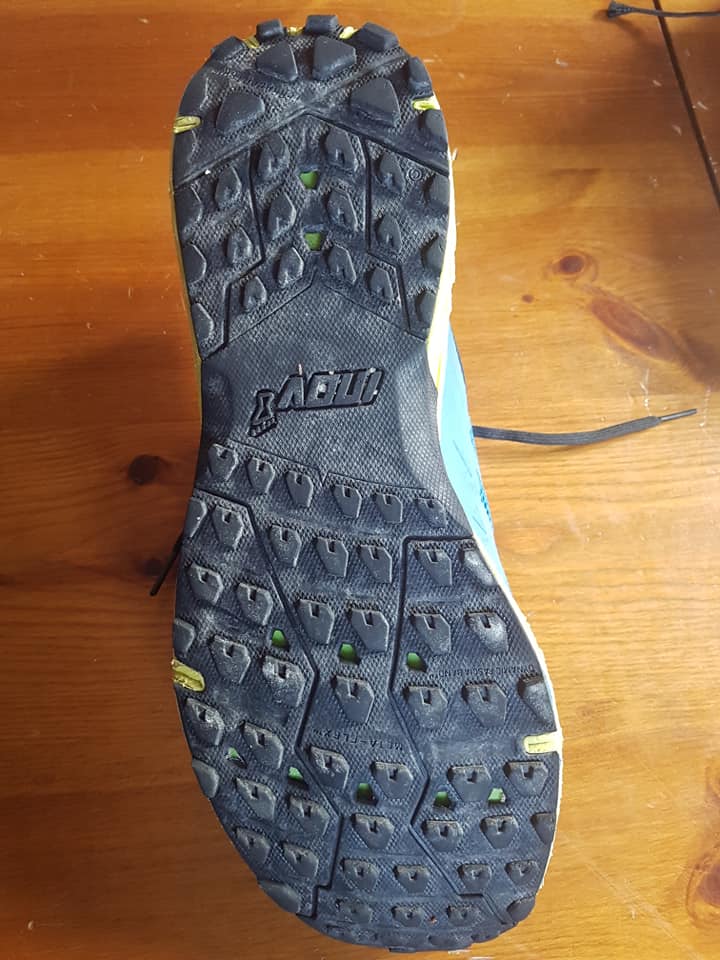
The tread certainly showing some wear on the rear outer edge but still plety of life
The other factor that makes Graphene so great is its durability. I would certainly have to agree that it does seem to be very durable. Considering the small size of the studs, I am amazed how much remains after the hammering I have given them. Chamonix is tough on shoes. Steep descents that put lots of pressure on the upper and sole. Sharp rocks that wear and rip things fast. The sole looks pretty good though with plenty of life left in it.
Graphene is good I admit, but I am not sure I can separate Graphene from Vibrams Megagrip and LaSportivas Frixion White, which inov-8 may argue, but personally I would take that as a big compliment.
Then there is the durability of the upper. It is in great condition. Over the last few years I have read many times that some people have had durability issues with uppers so I was interested to see how these fared over the test period. I can’t really see any wear on the upper at all to be honest. They seem to be really tough. I am impressed.
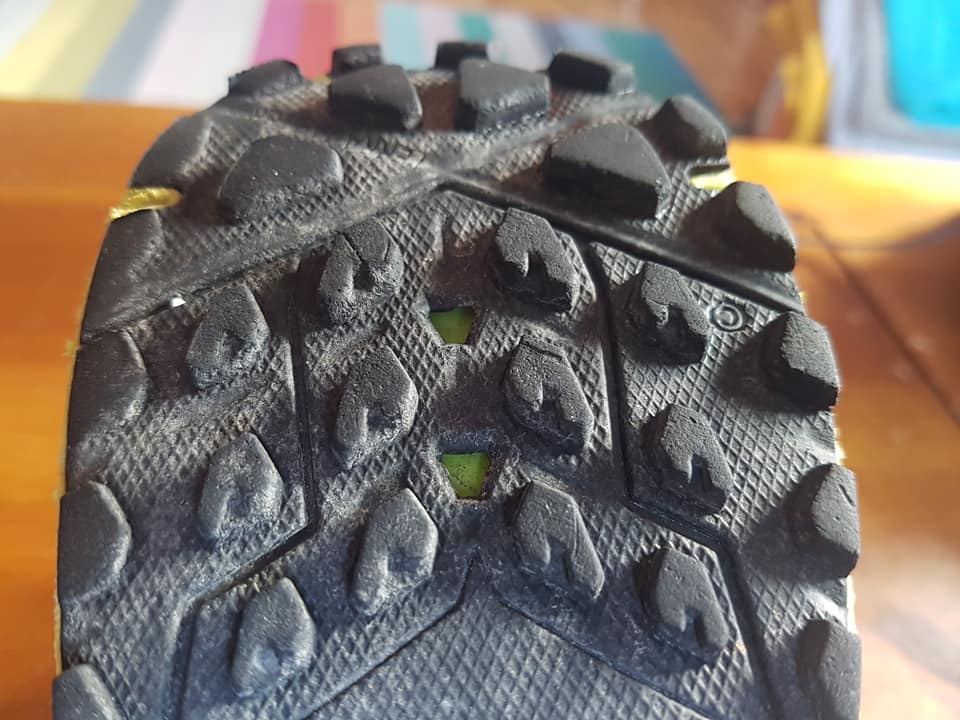
A close up of the rear of the shoe showing the most wear occuring on the rear outer edge (top left of image).
Summary
So, if you want a shoe specifically for hardpack trails, that is comfortable and durable, then this is a superb shoe. It really does do what they say. But if you want a pair of shoes that does it all, then this is not the shoe for you. It just can’t handle muddy terrain very well at all. It would be great if you need to run on the road to reach the trails too.
At £140 on the inov-8 website, it is not cheap, but somewhere in the upper end of trail shoes. Are they worth it? It’s a lot, but with how durable they are proving to be, then they are perhaps more economical than they first appear.
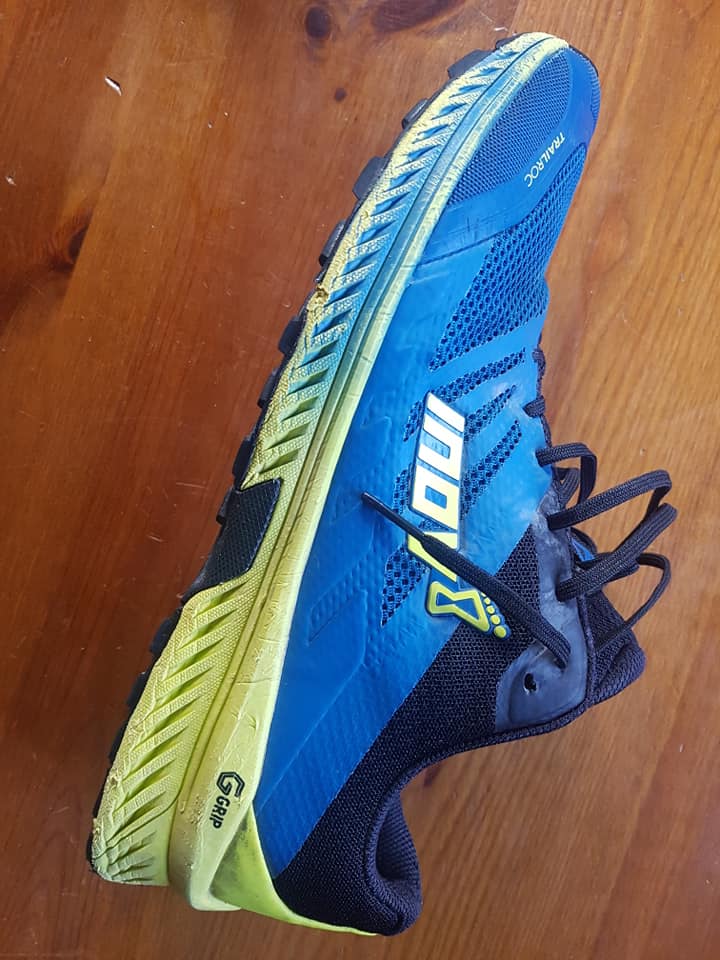
How much longer will they go...
A great shoe in its ideal environment. Well worth a look if you regularly run hard pack trails.
If you want to buy a pair of the Trailroc G 280 shoes and would like to help support the URC site, then please purchase from the following link
Written by Neil Bryant for the URC
*scroll to the bottom for update after 785km*
Full disclosure. I was given this pair of Kaptiva shoes for free to review.
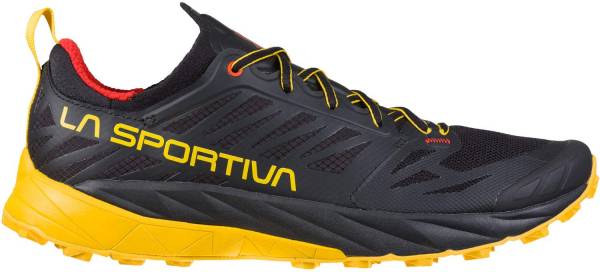
I first saw the Kaptiva when I was lucky enough to visit La Sportiva’s HQ in South Tyrol in Northern Italy last Summer. As you can imagine they had samples of everything they make there with a huge bag of sample shoes that we could test run but alas there were no Kaptivas as they just hadn’t gone into full production yet. They looked like a great shoe that was taking elements from other shoes and streamlining the whole thing. They seemed like a really polished shoe. A nice wraparound tongue, welded seams, lightweight, sticky tread and they didn’t look crazy narrow like so many racey type shoes are. This is great for my slightly wider than average feet!
I had quite a wait before finally getting my own pair to try on and test out. But they were worth the wait! The fit feels great for my feet and the full wraparound tongue really hugs your feet evenly all around. If you are familiar with the Bushido, then the tongue is similar to that, though the improved version.
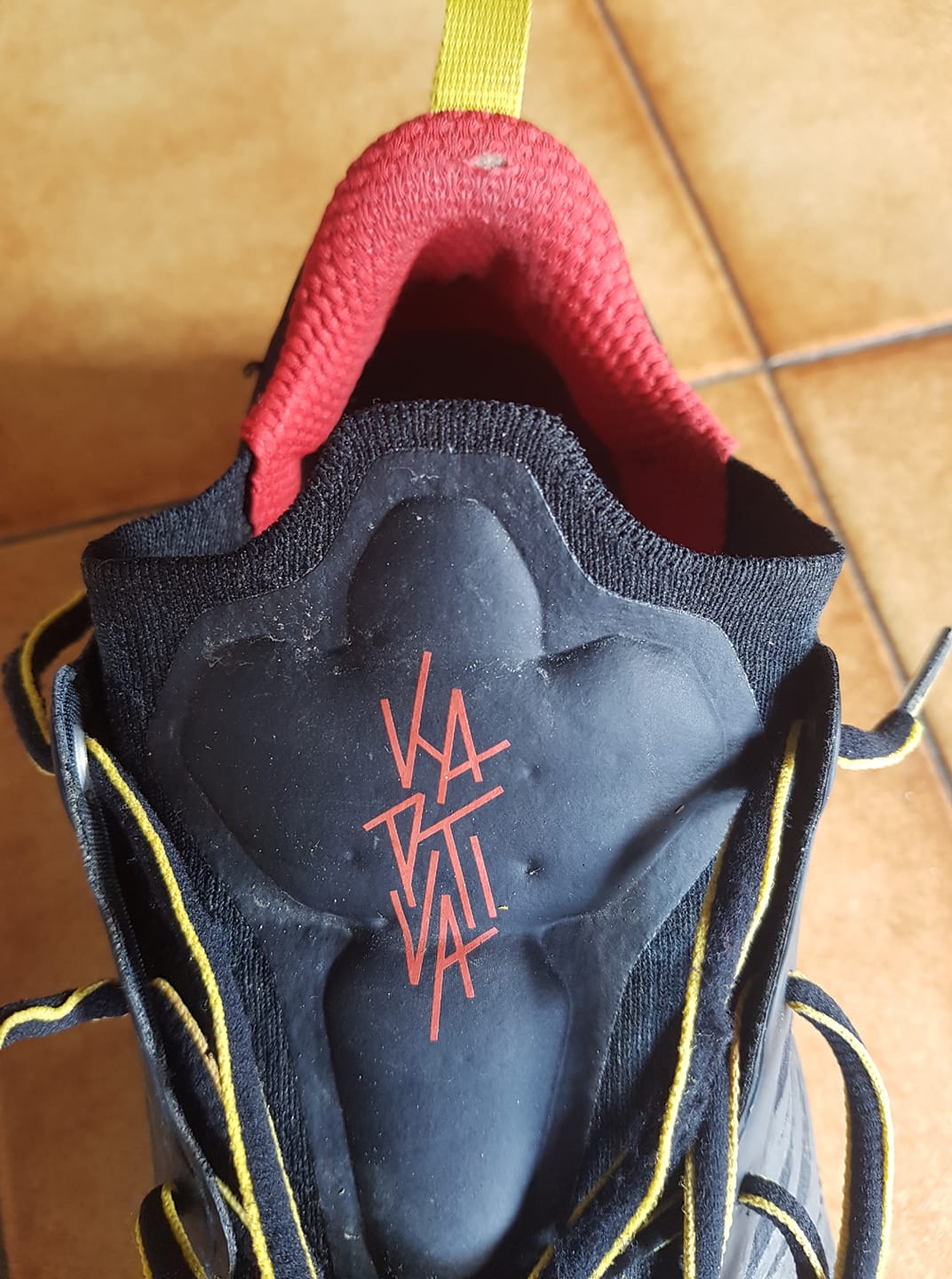
The fantastic wraparound tongue
The midsole gives a heel to toe drop of 6mm, with the heel being 17mm and the toe 11mm keeping you quite low to the ground which should add some extra stability and feel for the trail. In case this is possibly too thin for some (I thought it maybe for me as my feet hurt after a while on rough ground), they have added a 1.5mm Dual-Density EVA Rock-Guard in the forefoot & heel. I have found that some rockplates are not adequate for my softy feet (The Helios SR was one!), so I’d just have to hope they did the job once I’d done some mileage in them. La Sportivagumph describes the tread as ‘superior’ and the shoe being designed for technical terrain which seems to make sense when trying them on, but the proof is in the running!
I currently have racked up 280km on them so feel that I have a good idea about how they are now. I have run in snow, dusty trail, very wet rocky trail and even a few km’s of road.
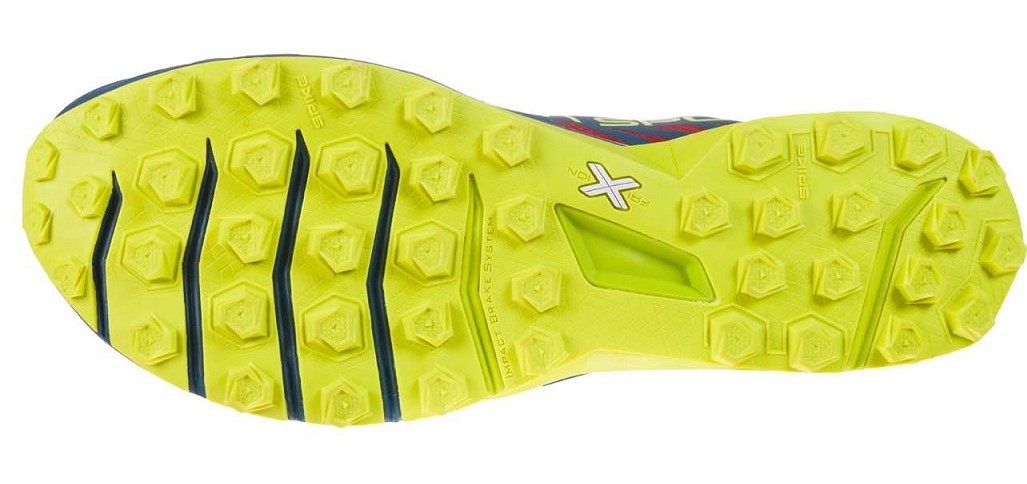
The fit is fantastic on my foot and the relatively lightweight of 260g means you don’t really notice they are there. The cushioning, Compressed Molded dual density MEMlex (I don’t know what MEMlex is!), felt good. Not spongy and soft but there was certainly enough for a comfortable ride. There is apparently a torsion-resistant insert inside which is supposed to add to the stability of the shoe on difficult terrain. I can’t say whether this works, but the shoe certainly feels stable on the technical terrain I have been running on, but I am guessing that this is due to many elements (low heel to toe, low stack height, foot hugging fit and grippy tread) so it is impossible for me to assess this one detail. I guess it doesn’t really matter to the user. I could say the same about therockplate. I found the underfoot protection ideal for my purposes. Whether this was due to the rockplate or not, I’ll never know. All I do know is it felt good.
Now the tread. This was probably the most exciting part of the shoe for me. Before putting it on, the rubber felt sticky and soft. I couldn’t imagine this not being an effective outsole! But I was concerned that this generally led to durability issues. I know you can’t have it all, but I hate it when shoe treads wear out long before the upper does (or vice-versa).
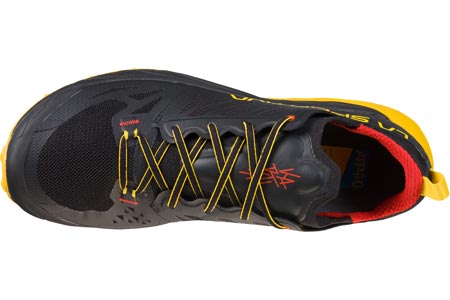
No real news here, but the tread is superb. It really is very tacky, and grips well on most surfaces. A little slipping on the wetter greasier rocks, but once you understand them then you adapt to it. Anyway, I have never tried a shoe that doesn’t slip on wetgreasy rocks.
Then there is the durability of the outsole. After 280km of trail, would you expect to see much wear? Well I am not too surprised to see a decent amount of wear. I will still be wearing them for quite a while yet, but the medium sized tread which consists of raised (either 3.5mm or 4.5mm) hexagons is starting to wear down considerably on the outer edges. Again, I know you can’t have superior tread and brilliant durability at the same time, but Is the wear acceptable and worth it for the grip? I think that if you bought these as a race only shoe, then maybe that would make the £140 price more acceptable. If you wear these all the time, then they aren’t going to last too long. I guess it depends on your expectations, budget and what you want them for (everyday shoe, racing). The upper so far is in immaculate condition by the way.
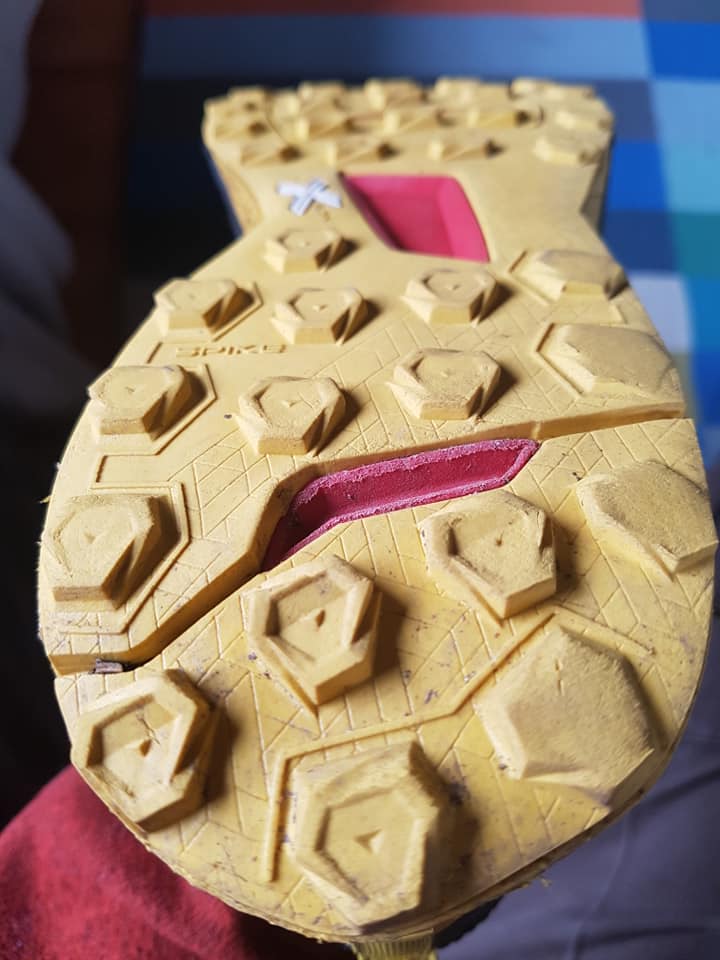
A picture showing the wear after 280km on trail on the heel.
So overall, I am really impressed with the Kaptiva. It is comfortable, stable, protected, the tongue is excellent, even the toe rand is spot on and there is a good feel for the trail. The grip is excellent (I can’t work out whether it is better or not than Vibrams excellentMegagrip so will say they are equal) and works well on really gnarly trail as well as road seeing as the studs are not huge. The shoe feels fast and nimble (if only I did!).
My only gripe, if you can call it that, is the durability of the tread. I have added pictures of the wear after 280km of Chamonix trails. It’s not a cheap shoe by any standard, but as I said previously it depends on your expectations. I know some people are not happy if their shoe is worn out at 800km. This might not be the shoe for them!
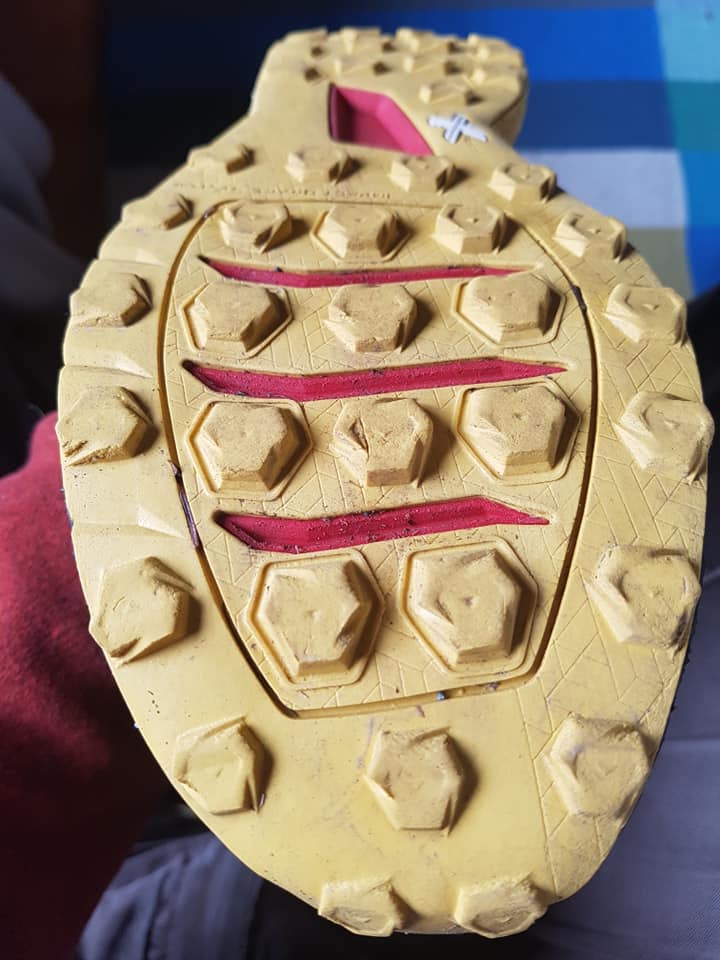
A picture showing the wear after 280km on trail on the forefoot.
I think overall I have to recommend the Kaptiva as it has got so much right, and runs very nicely. It is an excellent shoe which lives on technical trail, though is very adaptable. Well done La Sportiva, you really are improving your already great shoe line year on year. I look forward to see what is next!
Durability update
I have decided that a durability report is due on the Kaptiva as I have been wearing them a lot and giving them some serious abuse. They are now up to 785km and I will still wear them for a bit more. Basically in my opinion, my concern of the durability of the sole was unfounded. It has worn well and the upper also is doing well. They are basically as durable as I have found most La Sportiva shoes. So here are some picture to give you an idea yourself.
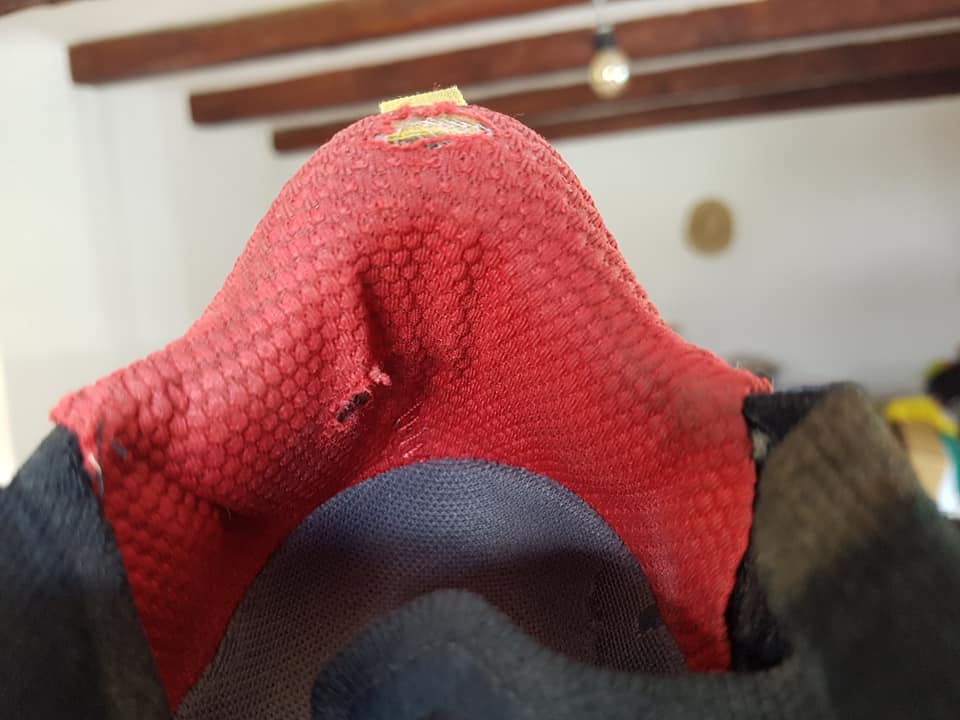
A little wear on the heel section. No discomfort currently.
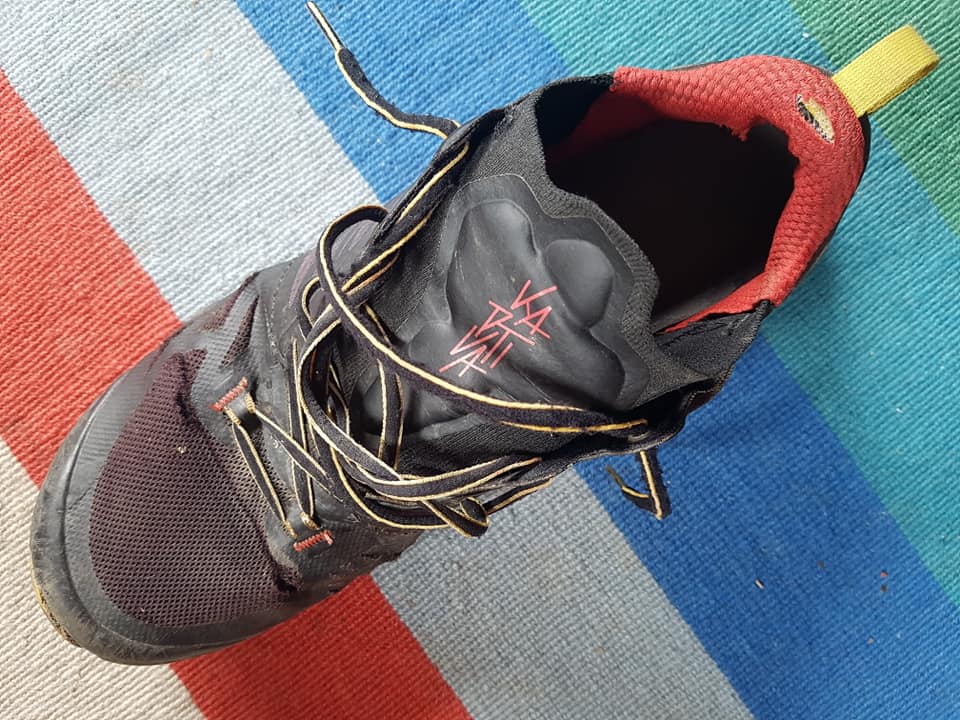
Looking a little battered but nothing of concern!
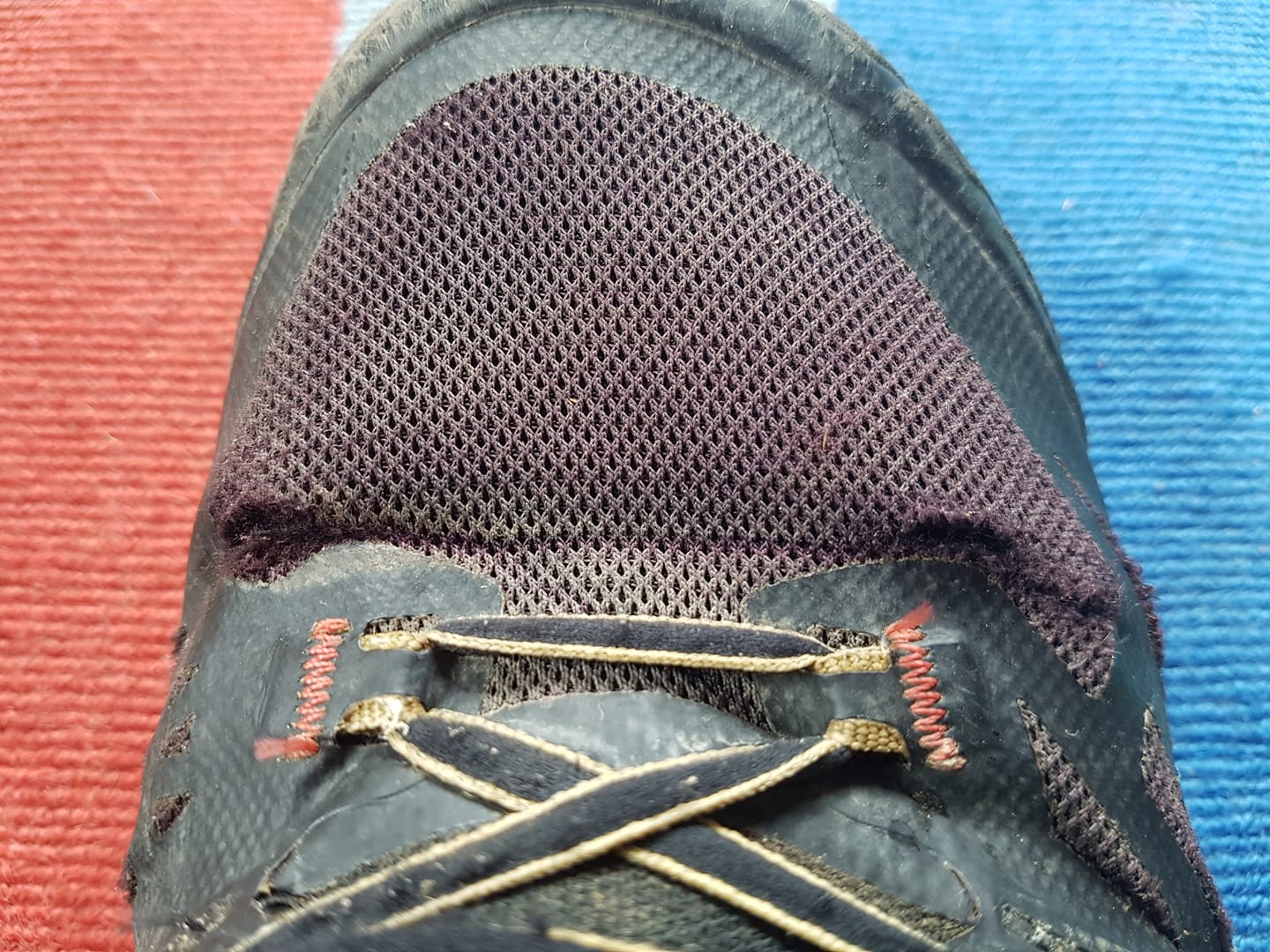
Showing the beginnings of holes in the common weak point of the toe crease. They have a liner though which prevents it being a big open hole though. No concern really.
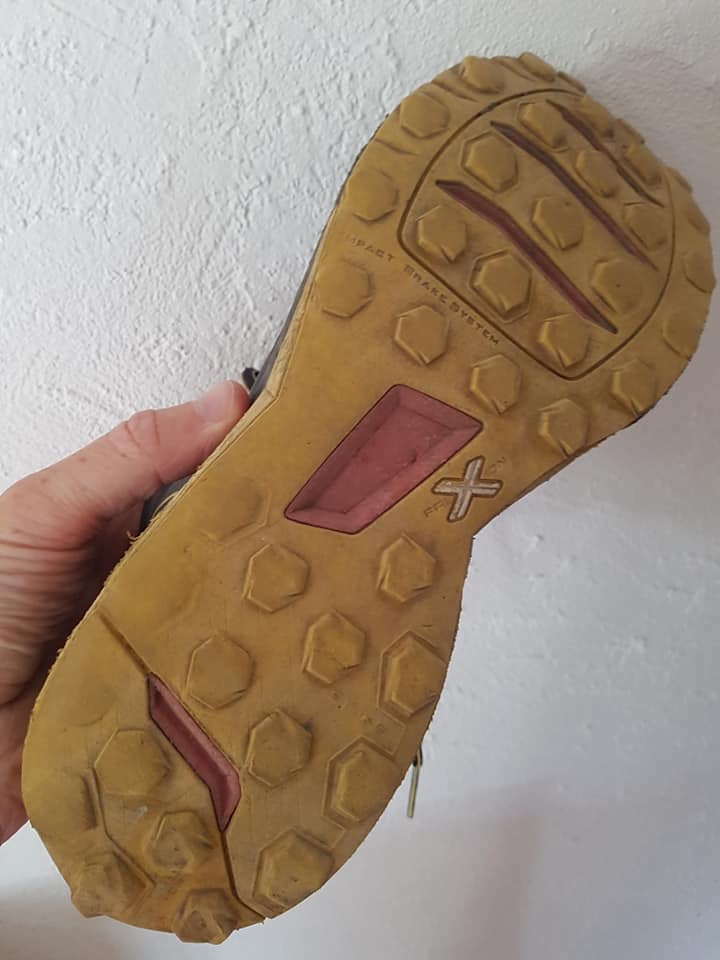
Certyainly looking more road shoe than mountain shoe, but I am happy with the durability considering the mileage and the stickiness of the rubber. Very impressive!
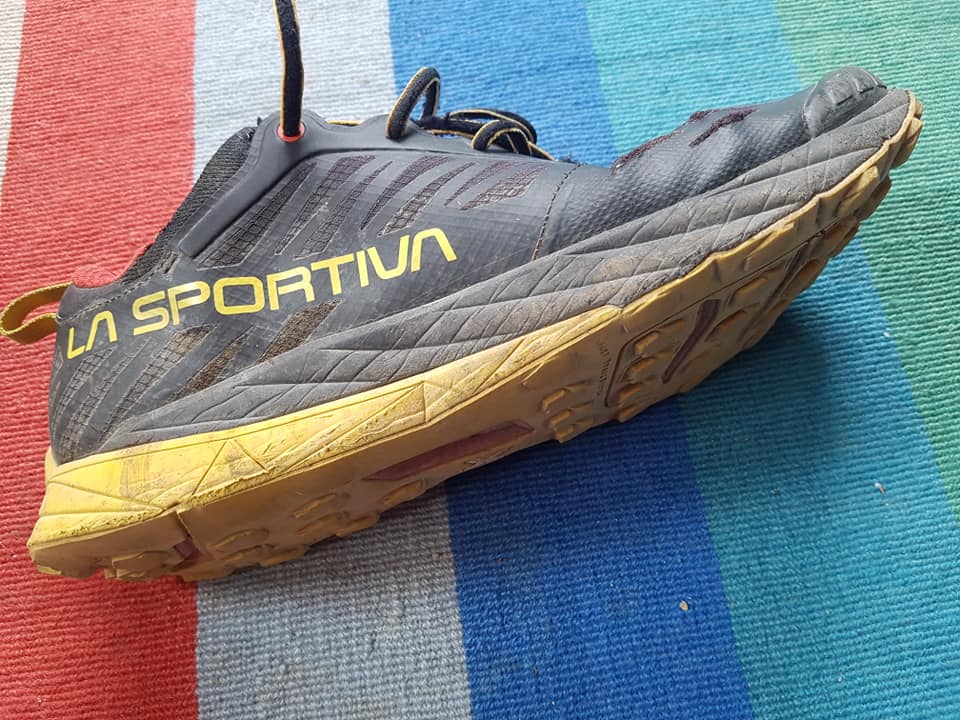
I will be sad to finally end their service.
Written by Sim Benson www.jenandsimbenson.co.uk
Price: £119.99
Weight per shoe: men’s UK11 335g women’s UK6.5 265g
Find out more www.361europe.com/en
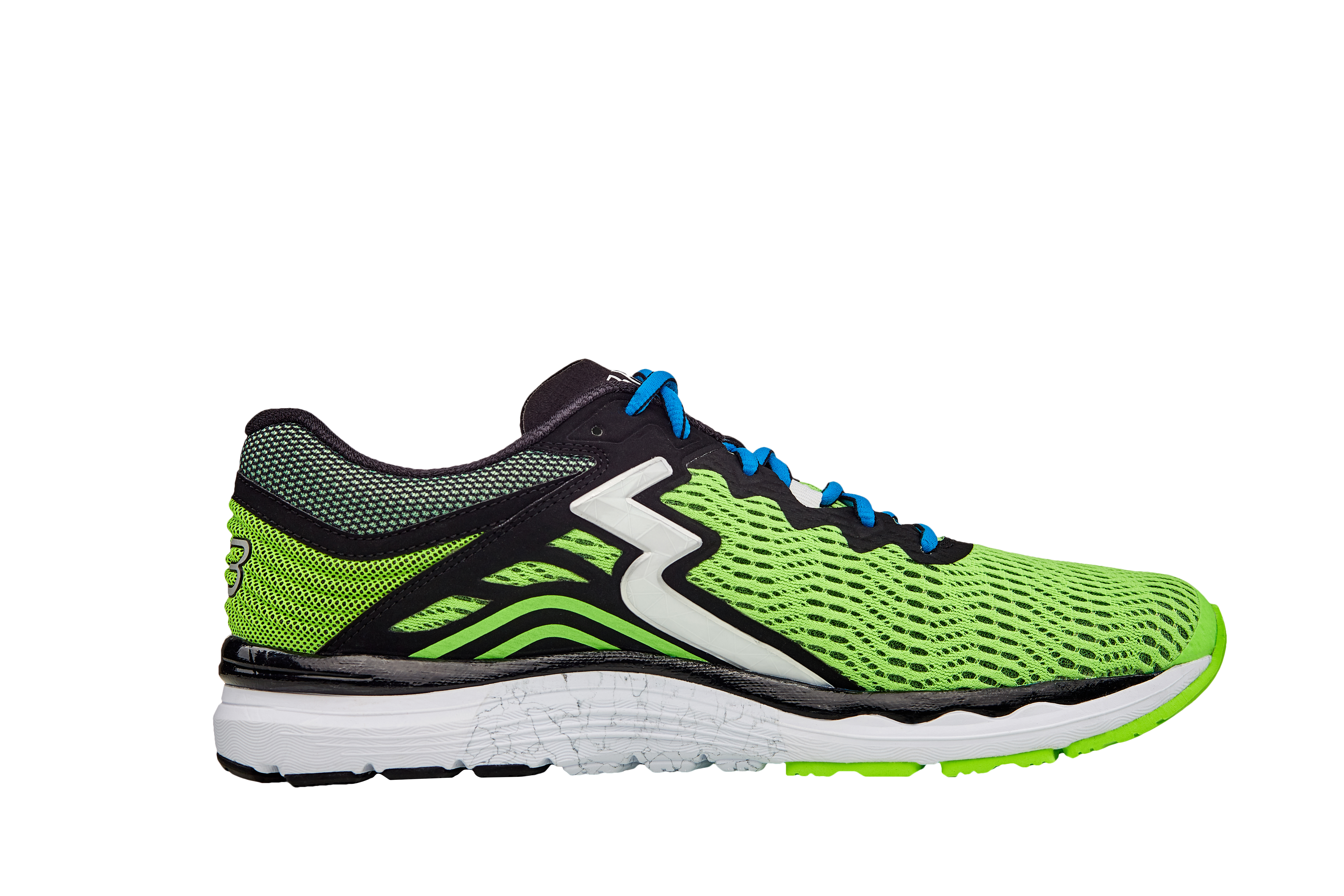
Overview:
The Sensation 3 is designed as a high mileage trainer with a good blend of weight, cushioning and some mild stability control – this is a pure road running shoe built for all-day comfort and protection.
At a fraction under £120 it’s also reasonably priced and it comes in some bright colours which we like. So, after a couple of hundred miles pounding the tarmac, here’s our review…
The Brand:
361˚ is a family-run Chinese company founded in 2003. Following rapid growth it became a major sponsor of the 2016 Rio Olympics. The Sensation – and as far as we can gather most of the brand’s other products – are made in Vietnam. We asked 361˚ about the ethics of the company and
production and got the following response, which doesn’t give much away:
“361 Degrees International is committed to designing and producing product that live up to the standards and expectations of fair, healthy, safe and environmentally conscious operations.”
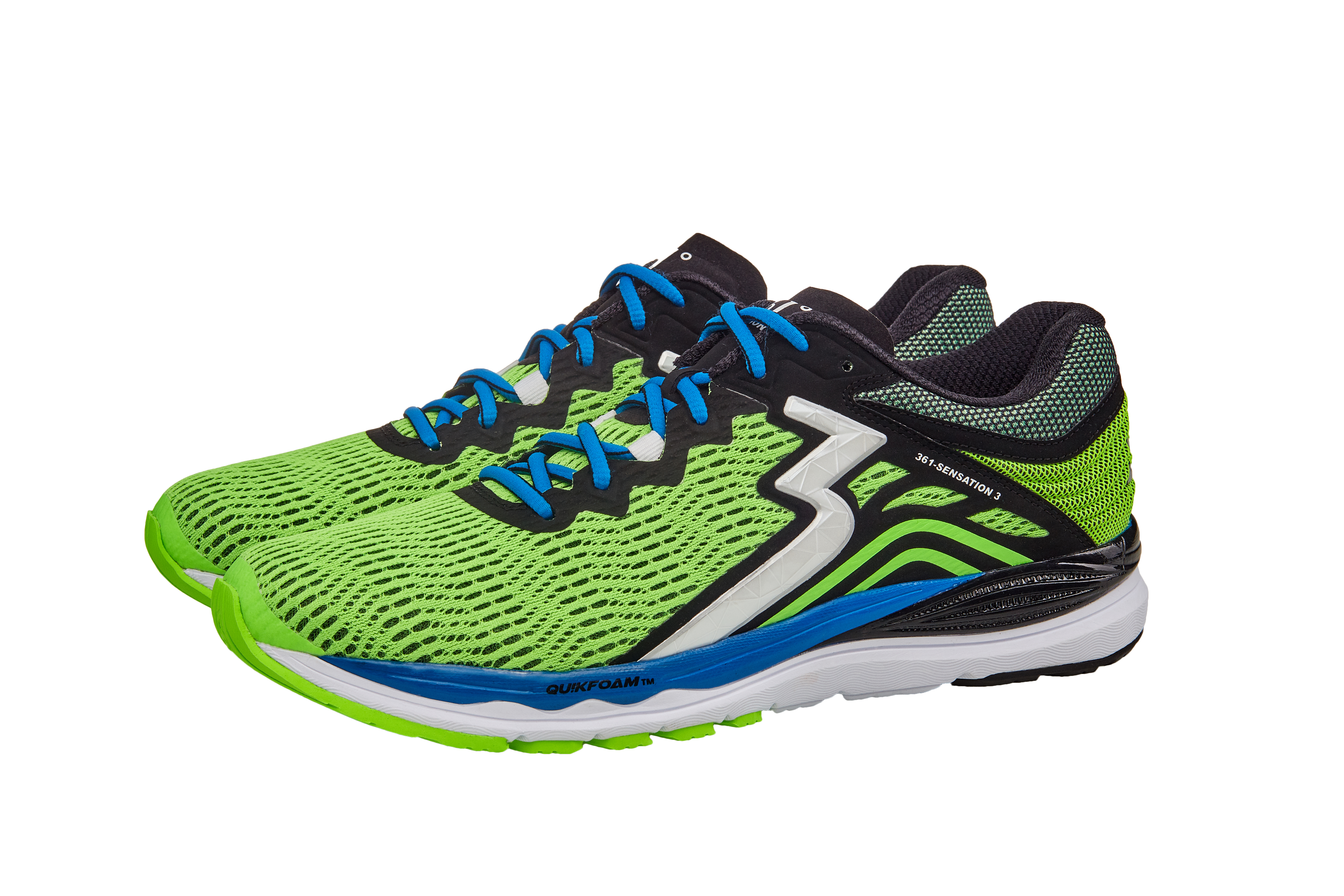
The Shoes:
The 3 rd generation of the Sensation is lighter and more breathable than its predecessors, removing some of the fabric overlays and lightening the sole unit. The straightforward design features a seamless upper, EVA and rubber blend midsole and blown rubber tread sections on the forefoot and
heel. Both the men’s and women’s versions are available in two different colours - one bright and the other a lighter colour - they really look like running shoes and couldn’t be called subtle.
The Fit:
Some reviews we’ve read suggest the Sensation is a bit narrow; it’s a similar fit to a standard Adidas or Saucony so at the narrower end but not unusually so. The stretchy mesh upper is nicely accommodating – good for those with higher arches. Length-wise the fit is larger than expected and
you may need to drop half a size, particularly in the men’s version.
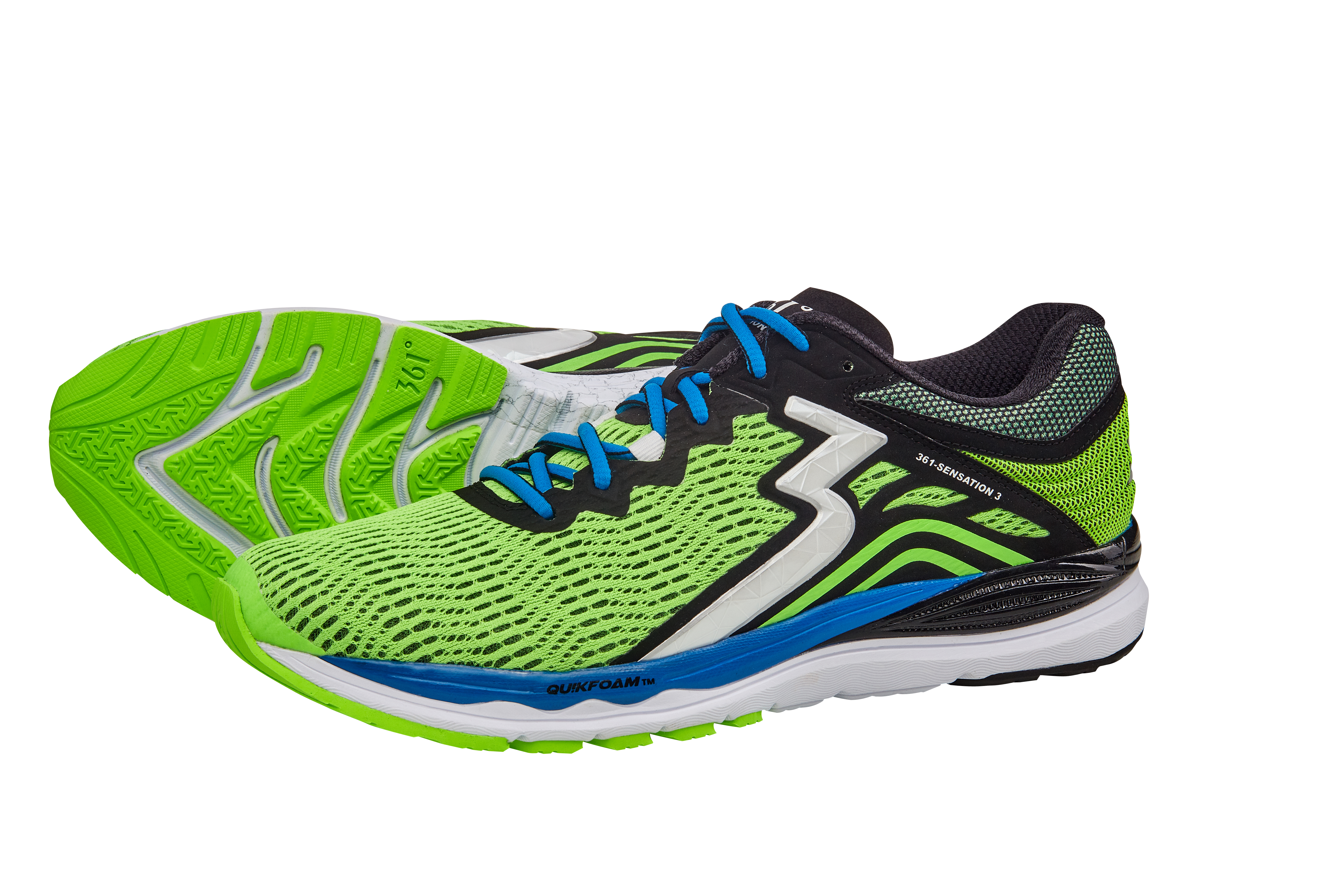
The Sole Unit:
The EVA and rubber blend midsole delivers a good amount of cushioning and energy return and should be more durable than plain EVA. A slim 12mm forefoot and 21mm heel stack height creates a 9mm drop which, in use, feels springy and responsive.
A carbon fibre plate – the QU!CK Spine – adds integrity to the midfoot and combines with the tread and the midsole to provide a comfortable and natural transition from heel to toe when running.
The tread consists of blown rubber sections moulded onto the midsole over the forefoot and heel areas, which leaves the midsole exposed under the midfoot, gripping as well as anything else on wet or dry roads.
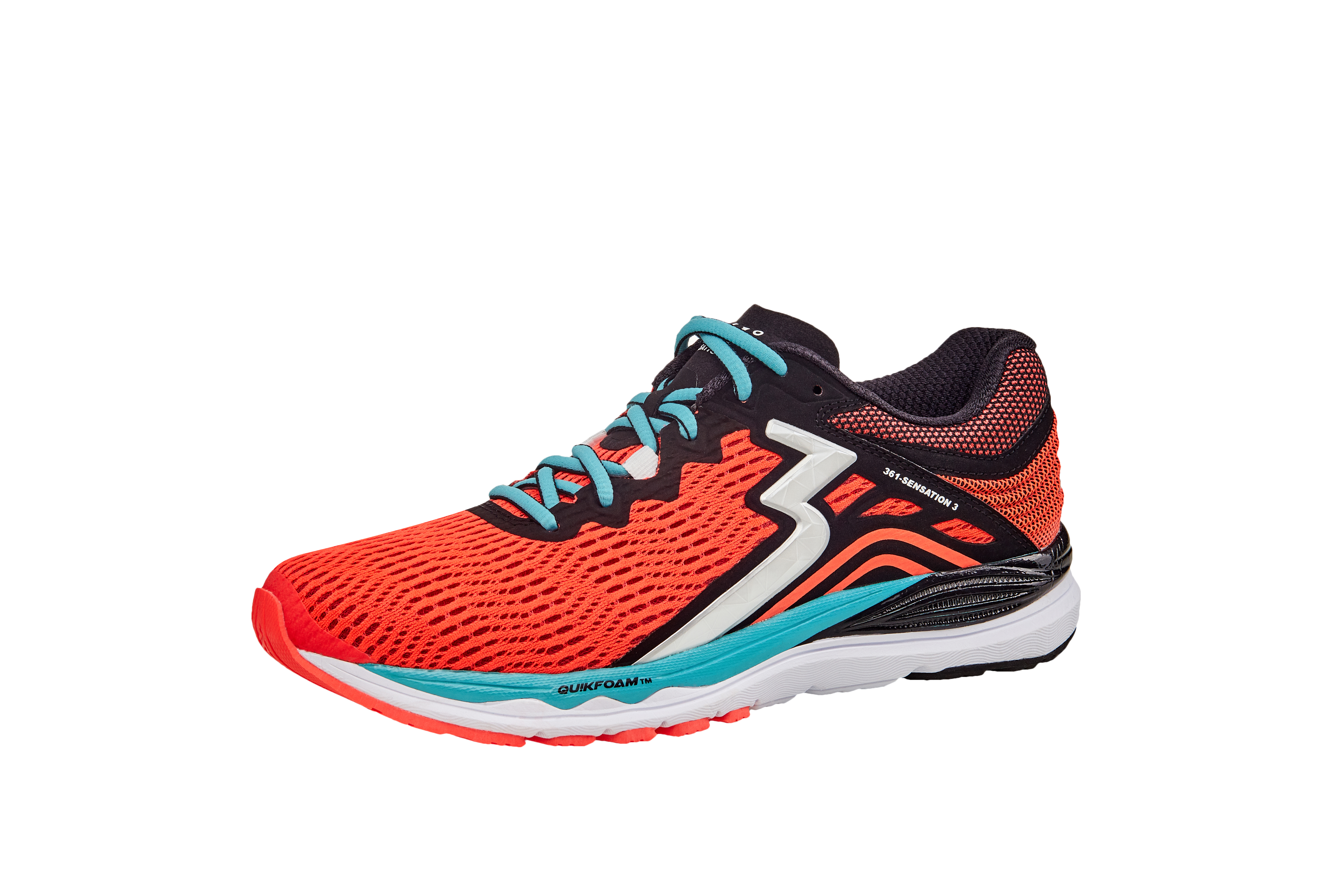
The Upper:
The seamless mesh upper is breathable and comfortable with a little stretch. The heel section is seamless inside and stiffened to provide support. The laces pull on soft internal webbing to hold the foot snugly and minimise foot movement. The tongue is thin but padded, designed to protect the
foot from the laces without causing any rubbing points.
Overall the upper holds the foot well in a soft and seamless cradle offering good comfort without the need for tight lacing to get a secure fit. Reflective logos on the heel and sides keep you visible.
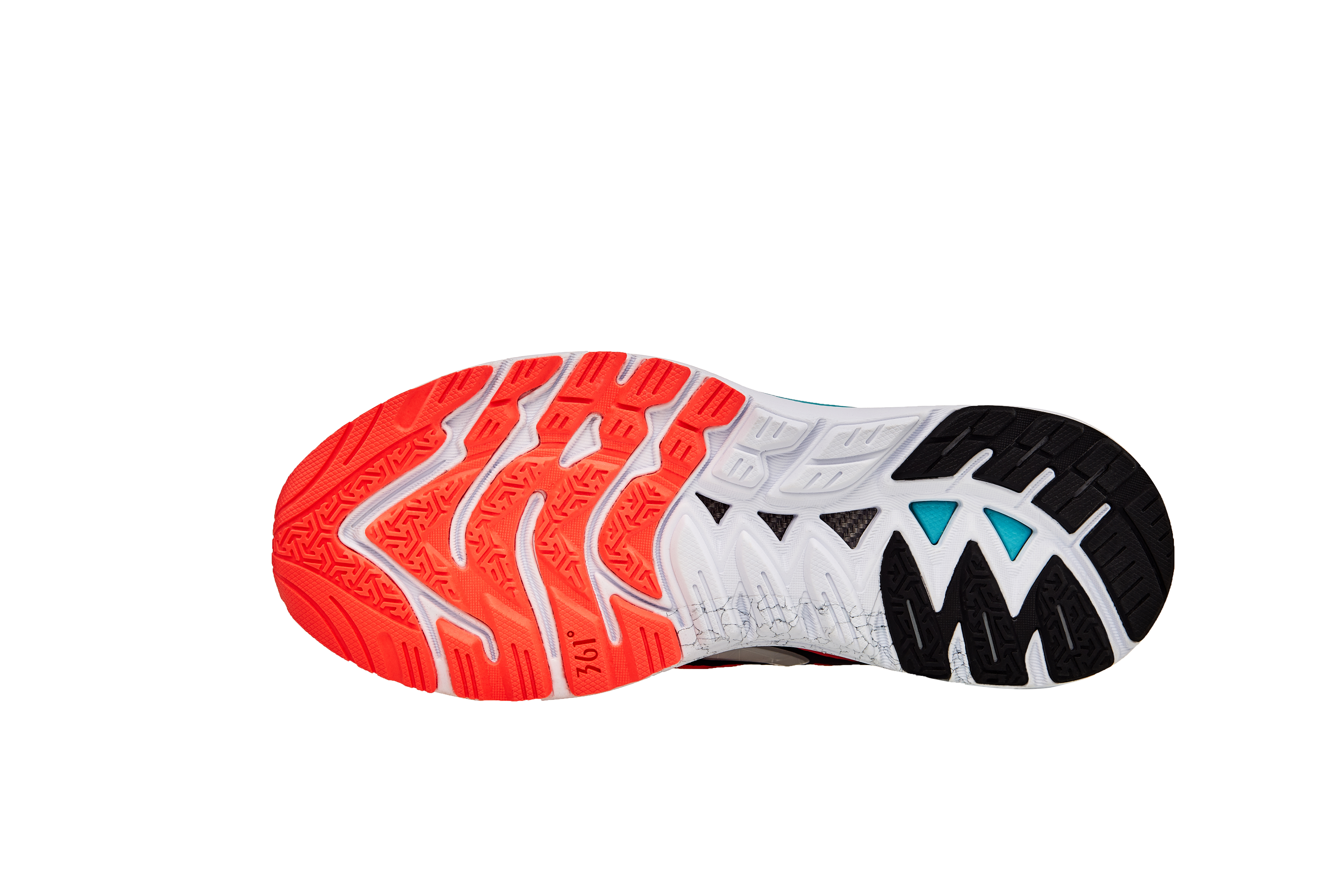
Verdict:
The Sensation 3 is a decent high mileage trainer. The low profile cushioned sole and soft but supportive upper combine with a low weight to offer a smooth and unrestrictive ride. After a couple of hundred miles they are wearing well so durability and workmanship appear to be good. The
slightly strange sizing (narrowish and slightly long) means we’d recommend you try them before you buy them, but if they fit well we’re confident you’ll enjoy running in them.
Written by Neil Bryant for the URC
I recently tested the Neutron shoe from Scarpa. It is a good, but very solid shoe. I say, but, purely as I know this won't be to everyones liking. Me personally, I quite like a dependable, rock steady shoe that can be counted on at all times, and has high levels of protection.Like a lot of you reading this though, I like to have a selection of shoes for different runs, in different condition and terrain. I also like to do some running in lighter and more nimble shoes. So next up for testing was a sample pair of the lighter (252g for a size 42) though not lightest (the Atom is a scant 3g lighter) Spin shoes.
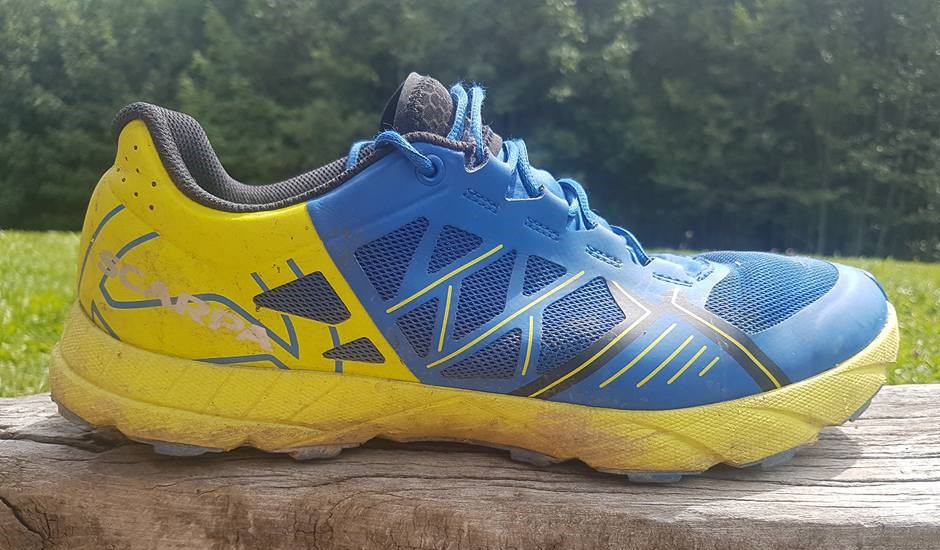
This is like the opposite of the Neutron, being light, very flexible in the sole, very low Heel to toe differential at 4mm, and athin tongue. One similarity is that they both have outsoles manufactured from the amazingly sticky VibramMegagrip. As far as I'm concerned, any shoe has the potential to be great if it has a Megagrip sole.
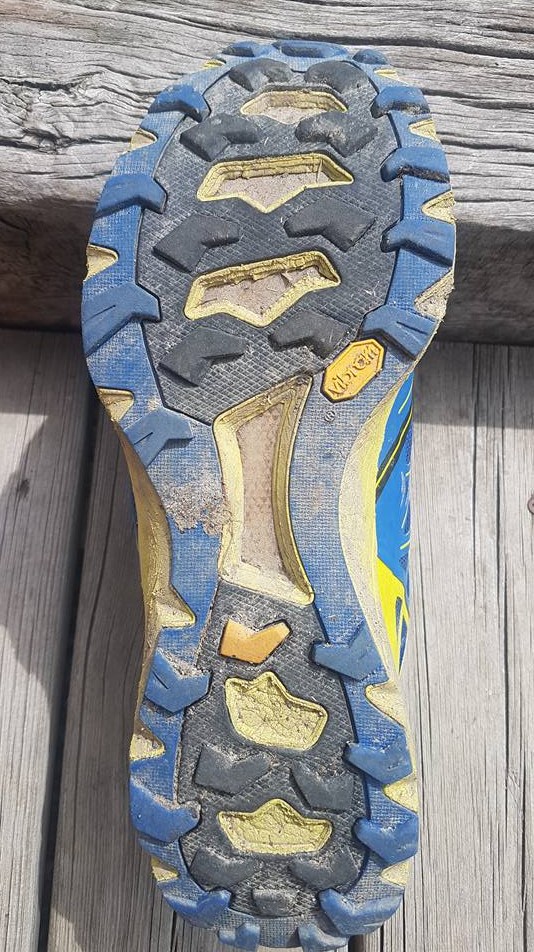
Whereas the Neutron was a very conservative shoe, the Spin, is a fast and exciting shoe. It initially reminded me a little of the Salomon Sense shoes, though with two big differences. Firstly, they are a lot more flexible than the relatively stiff sole of the Sense. Secondly, and this was very important to me, they are wider than the Sense, making them much better suited to my feet. They're not super wide, but if you also have troubles with the narrow Salomon fit (I know a lot of people do), then it could be worth trying a pair of the Spins on.
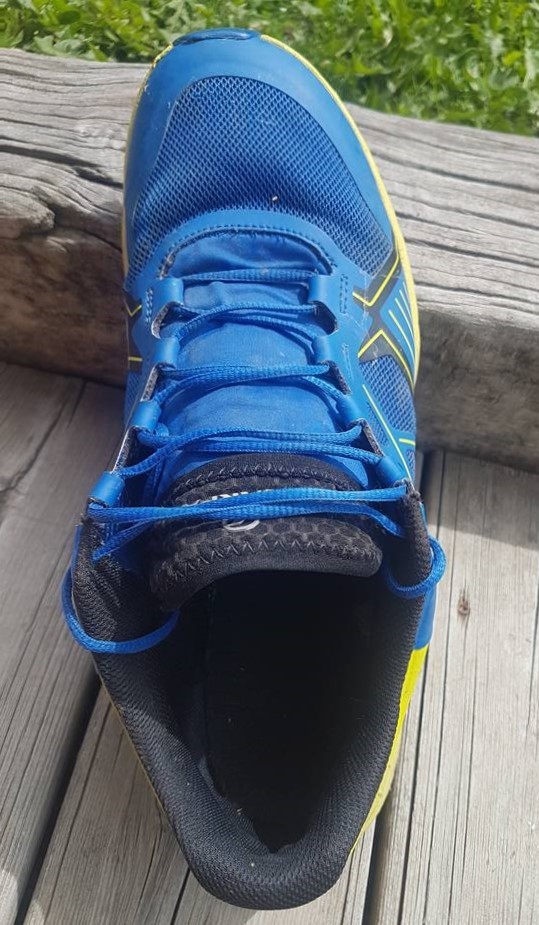
You can tell when I get new test shoes that excite me as I often don't get to take pictures before I've worn them. I tried them on and walked around for a while and knew straight away that they were a good fit for me. My first run was around two hours and by the end of it, my calfs were feeling the 4mm drop of the heel a bit. I guess I haven't really been running in shoes this low for a while now so my body was no longer used to it! I alternated between my Mutants to prevent injury.
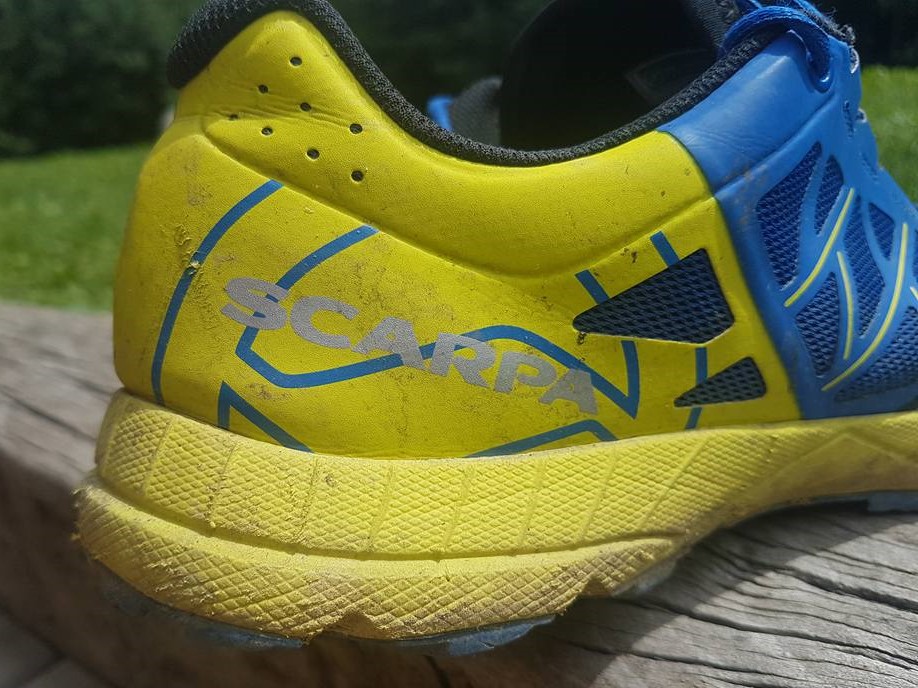
Now, as I have mentioned, the Spin are quite flexible, but within the EVA midsole is a high-density rock plate.This was a great addition as far as I was concerned to a light shoe. It has obviously not added much to the shoes overall weight. In practice though, over the sometimes brutal, technical trails that are littered with horrible sharp, pointy rocks here in Chamonix, the protection was lacking a bit for me. I would love to have just a little bit more to give me more comfort on the descents and therefore allowing me to let go a bit more.
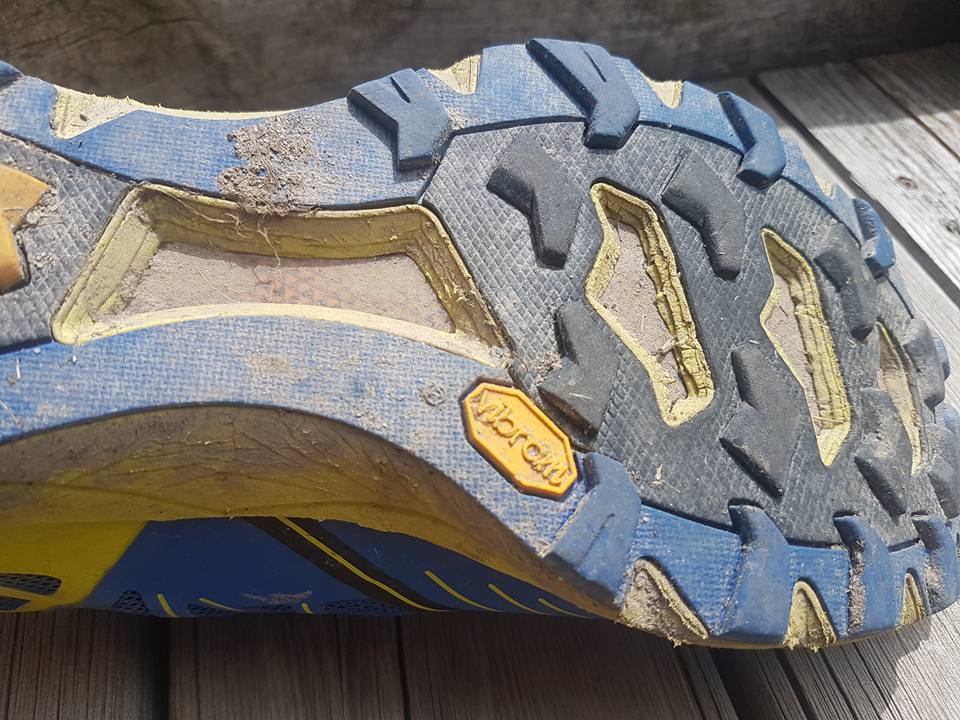
The Megagrip sole, I of course love, but how is the actual tread pattern? I can't really fault it as an all rounder mountain shoe. It sticks to rocks, wet and dry, like a limpet, and there is enough depth to cope with some mud, but it would fail in deep mud. This shoe belongs in the high mountains on technical, rocky trails. There are cut throughs in the tread that expose the rock plate (I think?). This obviously saves weight, but of course you are losing some, for me, valuable protection here from those sharp pointy rocks.
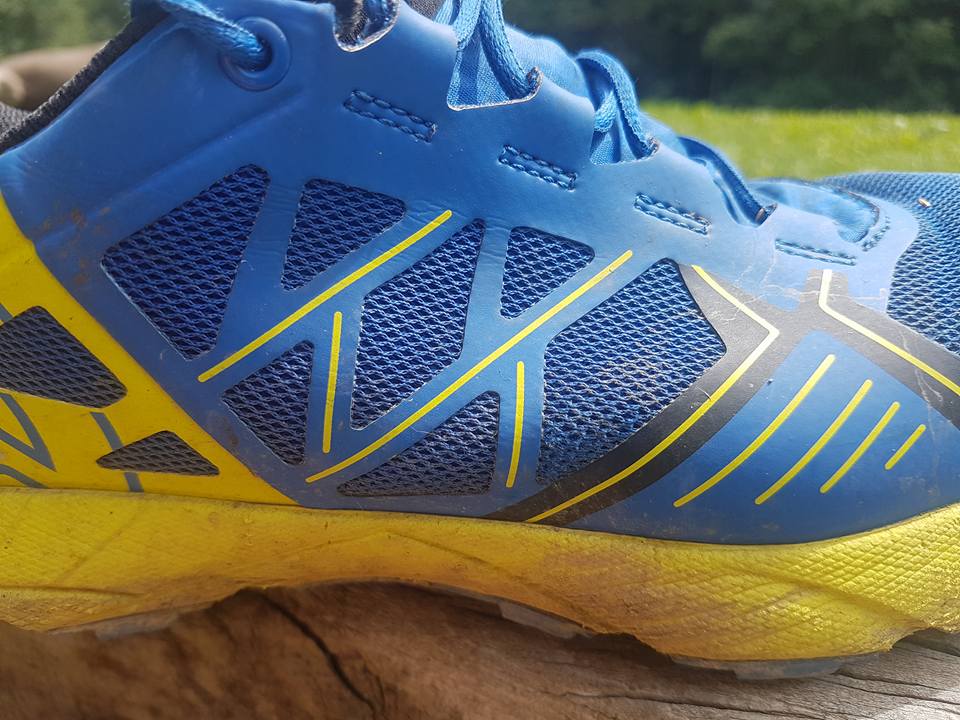
The upper is almost completely held together without stiches, being welded together. It is thin and airy, which is great as your foot gets to breath and water easily drains. The tongue is fairly thin, and gusseted with elastic, which helps prevent the ingression of grit, and gives you a bit more of a custom fitas it hugs your foot before you've even tied the laces.

So overall, I think a slightly beafier rock plate and not having the cut throughs in the tread would have made this a faster shoe for me, as I would be able to descend quicker. Other than that, I can't think of anything else that I don't like. I am finally adapting again to the 4mm drop so am really enjoying them. They feel great on uphills due to the fit and weight, but also because of the great grip. The fit is fantastic on my feet. I have done a couple hundred kms on them now and the outsole is showing a little wear, but the upper seems to be bombproof as it’s showing no real wear or tear. Pretty good these days for a light shoe.
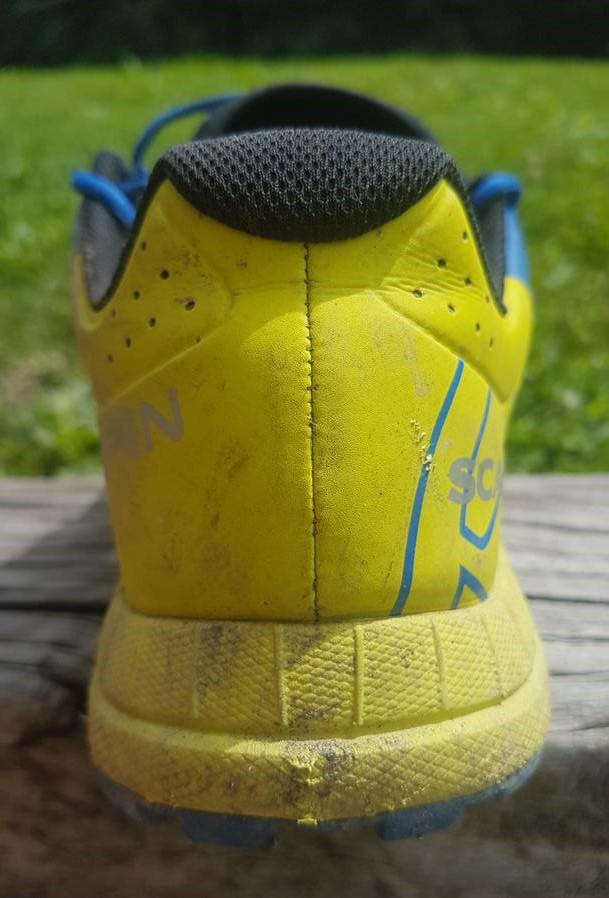
I have a place in the monster 200 miles Tor des Geants in 6 weeks and I am starting to think about gear. Although the comfort is so good on the Spin, the protection is no where near good enough for me. So, I shall be looking elsewhere. To be fair, I would say that the Tor Des Geants is not what they were designed for!
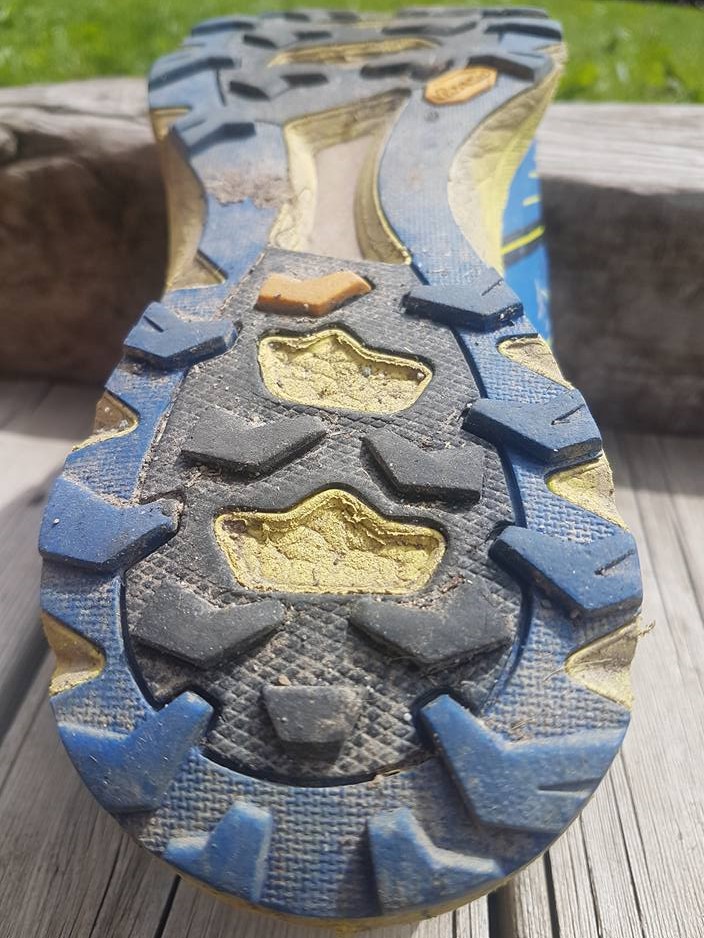
So, if you want a light, flexible and therefore nimble shoe to run around alpine trails, and you are either lighter on your feet than me (not difficult) or just don't feel the pain like I do, then the Scarpa Spins are certainly worth trying out. Scarpa are really proving to be a force to be reckoned with on the mountain running shoes market!
Written by Neil Bryant for the URC
A few years ago when I was doing some fairly high mileage, mostly on road or hard pack trail, I was suffering from very sore balls of my feet. It felt like the metatarsals had no padding to soften each footfall. I had had them looked at by a few specialists and had tried a few things but nothing seemed to relieve it.
I was willing to try anything that would help with the pain and keep me running. Now was my turn to try Hokas. I'll be honest – I had steered clear of the platform shoes so far. I like to think that image is not important to me, but Hokas proved to me that I did care. I thought they looked insane. Not only that, but they just didn't make sense to me. I liked being fairly close to the ground and was concerned about going over on my ankles being so high up.
Anyway, I got a pair and they were high! I forget the model. They were amazing fun running down hills on the road. But sadly, the reason I got them, to ease the pain in my feet, they had no effect. So after a few weeks, I gave up. From then I didn't take too much of Hoka shoes.
That was until they started doing some non-platform style shoes. Something a little more traditional.
The Hoka Speed Instinct relit my interest in Hoka and I wanted to give them a try!
They are light at 225g, have a very low heel to toe drop of 3mm and look pretty cool in the super bright, Euro colours I had. More conservative colour plans are available for those who are not so keen.
When I pulled them out the box, they felt super light and I noticed the ample padding around the heel and the tongue. I generally don't feel the need for so much padding as it just absorbs more moisture and stays wet. I am open to it though. Time would tell.
The midsole is made with a rather soft and squishy heel section and a firmer forefoot section. Hoka have named this PRO2Lite. It is supposed to add a comfortable heel strike and a responsive toe off. Simple but actually could be a good thing as long as the heel is not too soft.
Hoka also have added their 'Early Stage Meta Rocker', which I believe means that the sole is curved to aid you stride from heel to toe. Many companies have something similar, and generally it feels good though I have generally lost the rolling sensation when on technical ground.
The tread I was less excited about. It didn't look like a great pattern and it certainly didn't just feel sticky like some soles do. Again, this was something only testing would reveal.
I first managed to get out in these back around Christmas time when I was back in the UK. I ran on woodland trails, a little road, canal tow paths and even did some hill efforts on a wet slippery rocky trail. They felt absolutely great on my feet. Just a fantastic fit. Heel was super comfy and the toe box was just perfect for my feet. I have fairly average feet that if anything are a little wide, but not much. I had been advised to go half a size up from normal which seemed good for me.
The soft heel was very noticeable and I liked it. It seemed to have enough protection to prevent sharp stones poking through too much. They felt great on the tow paths. Well suited for long days on the hard pack terrain. They were fun and fast on the twisty woodland trails. I had a few slips on wet tree roots. Nothing unusual really. Not a lot sticks to tree roots!
They were really nice for the hill repeats I did. The trail I was on was not at all technical but it had lots of slick rock and I kept slipping and sliding. Again, I thought, this is something that many shoes wouldn't cope with.
We then returned home to Chamonix and the shoes didn't get worn for a couple months as I was skiing. As the snow melted it was time to get back out running again and out came the Hokas. How would they cope with Alpine terrain, snow and lethal slippery rocks. I admit that I was a little nervous.
Over the last couple months my confidence has grown for the tread. I am not going to say it is great, but it works if things don't get too testing for it. It is the weakest part of the shoe in my opinion. But let's get this into perspective here. I would still rate this shoe overall. The comfort is just amazing for me, and I still really like the soft heel. I really find I can let go a little more on the steeper descents. I have run some of the local descents faster than before while wearing these shoes. My longest run in them is around 5 hrs, but I feel quite confident that I could run way longer, in relative comfort in them.
I am not sure they need the extra padded heel or tongue but I guess I'll never really know whether they do make things more comfortable or not. As I write this though they are next to me, soaking wet from todays run up into the snow, and they do seem to be drying very slowly because of the padding.
What would the Speed Instincts be good for? I would say anything dry, hardpack and fast. I wouldn't take these up into the marshy boggy areas or if it has rained a lot and there is a lot of mud or wet rock.
So, after a big period of not really noticing Hokas, the Speed Instincts have bought them back into my sights. Hoka are onto a winner here. The Mafate Speed 2 from Hoka has a Vibram Mega-Grip outsole and I so wish they had used the same for the Speed Instict. It would have been so much more adaptable to different terrains.
These are certainly worth the try if you can. If you are lucky like me with the fit then you are in for a treat! Fast and nimble and even work well on the road, so would make a great door to trail shoe. Good work Hoka, maybe I'll have to try some of your higher shoes again!
Written by Neil Bryant for the URC
I recently got a chance to review the rather amazing Salomon X-Alp Carbon GTX and what an incredible shoe (boot?). It is basically a super light mountaineering shoe that can be taken into the high mountains and with certain features such as being able to take a crampon, decent edges on the toes for easier climbing/scrambling and a gaiter for keeping snow and grit out it is just amazing to wear instead of some very heavy mountain boots. Of course the shoe was designed for moving fast and safe in the mountains so the combination of the low weight and the slight flexibility meant that this shoe could also be run in. Now, of course a shoe that covered so many disciplines could surely not master them all or indeed any, but the weakest point for me was the fact that they were not brilliant for running in. They just didn’t feel remotely like a runner. Maybe I am being harsh about such an adaptable shoe?
Whatever your thoughts are of Salomon, one I think we could probably all agree on is that they are constantly pushing the boundaries and coming up with some really interesting stuff. Truly Innovative! It’s not all a hit, but that is what makes what they are doing all the more exciting. They are willing to take the risk to produce the right product for their athletes.
So, with the Carbon GTX already out, where would they go next? Well, I guess that I wasn’t the only one to think the same about the running performance, as they redesigned it completely but this time trying to make a shoe that does all the above but is simply a better runner too.
So how would they go about achieving such a design brief? Well, a good place to start would be with the incredibly popular Sense platform. After all the Sense is to many a fantastic mountain running shoe (if you’re lucky enough to have the right shaped foot). It is quite cool to fold the gaiter down on the black XA Alpine, only to be greeted with the bright red sense shoe hiding within.
There are key sense features such as Sensifit, Quicklace (love it or hate it), and Endofit which all makes for a super cosy fitting shoe, which will feel very familiar for Sense owners.
Then you need to sprinkle in many of the features from the Carbon GTX such as the protective toe cap which is good for when things get a bit more vertical and less runnable, when your toes tend to get crushed in normal runners. It also adds a little more stability for when you need crampons.
The gaiter comes all the way down to the midsole and is made from a tough fabric which is great for if you are scrambling on rough rock. Granite takes no shoes prisoner! This is a necessary.
There is also a protective ankle pad on the inside of each. This is good for protecting your ankles from crampon scrapes which can be very unpleasant!
Then there is the superb carbon chassis which I found to be so effective on the carbon GTX. This is a carbon plate which has cuts in it that makes it fairly flexible from toe to heel (good for running) and stiff from side to side (good for climbing). Believe me, this is a great technology. It works well enough to climb in without having a solid sole.
The climbing zone is just a solid rubber outer section on the tread pattern around the toe. This adds much more stability and friction for climbing. If you have climbed in trainers with a fairly luggy tread on them then you’ll understand how good this is!
The final feature of course is the gaiter which envelopes the whole shoe and keeps all debris out which I have found to be great when using this out my door up the trails then into deep snow. With no gaiter my feet would be totally soaked and very cold as the snow just gets in, compacted, then I have ice in there! I don’t mind snow in my shoes if I am on the snow for short periods, but over prolonged periods, it gets really uncomfortable.
The outsole is very similar to the carbon GTX and nothing like a sense. It is an open pattern of studs and they are fairly robust, making me think more of mountain boots that running shoes.
So, I have run a fair bit in these now, and been trying to give them a good testing in the environment they are designed for. I have had a couple pairs of Sense before so knew how the fit would be. Unfortunately for me they are almost a great fit, but not. They are just a little too narrow at the front. This is of course not an issue with the shoe, more my hobbit feet.
I personally find the quicklace a good system once you get used to doing it up evenly and not cutting into the top of your feet. Once I’d squeezed my feet in, pulled the laces tight and then zipped up the gaiter, I really wanted to go out immediately!
They felt great and like a completely different shoe to the Carbon GTX. They are less bulky and so feel more nimble. The sole is quite stiff, but not too much. It certainly felt adequately protected. Enough, I needed to run them!
My first outing was from my house, straight up the trails to the flegere ski area. It wasn’t open for the season, but there had been a dump of snow. The snowline was about 500 vertical metres above home which was perfect for testing as it meant they got plenty of dry trail, wet trail and snow to go through.
Above the snow is a small valley with a few cols and little peaks and I was popping up there often and having a little explore. Each time I wore the XA Alpines.
They surprised me with how good they felt on the dry trail. The paths I was using are fairly technical and steep and I always felt as though I was in ‘normal’ trail shoes. I felt confident and sure with my footing. The tread seemed effective.
Then the wet and slushy trail for a short while before the decent snow. Again, running through perhaps my least favourite of conditions underfoot and they made light work of it. The gaiter now was working plenty and keeping the snow and slush from getting in. My feet, other than sweat, were dry. Very nice.
Then I reached the snow. Over the test days, I experienced very deep snow, Very thin cover (so the rocks were hidden from view but not your feet), wet and heavy snow, Beautiful cold powder Hard frozen neve and plenty of awful breakable crust. The XA Alpines coped as well as any shoe could, they were protective from hitting rocks, the gaiter was superb, the tread was all you could ask for (while still being good for running) and you could even kick steps into neve.
One day I headed up a couloir and discovered some horrible crust to rip my shins apart. I decided to don the crampons I had. They weren’t as comfortable as on a super stiff mountain boot of course, but I wore them for over an hour and they were fine.
I have also taken them around a small scrambling/climbing circuit that you can race around quite quick which I thought would be ideal for testing the climbing abilities on rock. Seeing as I had recently tested the Carbon GTX, I was not surprised to discover that they were brilliant. You could use the edges to great effect and safely on very small holds. Also, jamming them into cracks was not agonising due to their stiffness unlike normal runners which tend to let your foot get crushed.
Could I find any real flaws? Now, I appreciate that this could well be very personal, but my feet got super saturated in sweat which was never pleasant. I think I do suffer from overly sweaty feet anyway so maybe this is just a me thing. Anyone out there have a pair and can comment on this?
Overall though, I am seriously impressed. Salomon are really pushing the boundaries on footwear at the moment and I love this innovation. I am also excited to see where it will go. I don’t think anyone else is making shoes similar (maybe I’m wrong). The stiff sole, gaiter, lightweight and being a good runner are an interesting combination that when all thrown into the pot, come out as a very able mountain shoe that can move fast below the treeline, above the treeline, in the snow, and over rock.
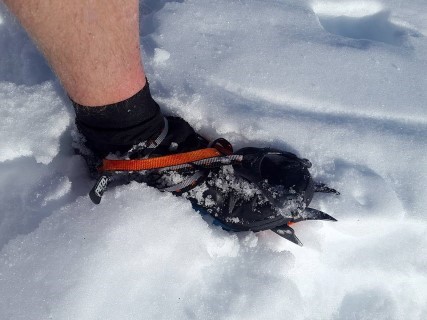
Who is it for? Well I’m guessing that if it’s for you, you’ll probably already know as the features will just make sense. I have really enjoyed the surprising lack of compromise for each different terrain they cope with.
Finally, a few people have asked what they would be like as a pure trail runner. Well, that’s not what they were designed for, but if you are after something a little more solid with a gaiter and the sense shoe fits you well, then I think it would suit some people for bigger events on difficult terrain. I won’t be using it for just trail running though.
Written by Neil Bryant for the URC
Scarpa are an Italian family run company that have a long heritage of producing some of the finest mountaineering boots in the world. They also make some great ski touring boots, and rock climbing shoes. It seemed like a natural extension to start making trail running shoes. After all, it couldn’t be that difficult with their knowledge and experience… could it?
The more shoes I run in, the more I realise that it must be quite a fine art designing a good running shoe. And of course, what will be the best shoe ever for one man, will be the most awful for the next, so I am never too expectant that a shoe will work or won’t with me and my feet.
I own an old pair of Scarpa mountaineering boots that feel good on my feet, yet that doesn’t mean a great deal as they will be made on different lasts.
So, enough second guessing! I was advised to go up a size, but they were too big, so went with my normal size 43, and they felt good out of the box. My feet are not that wide, but are certainly not narrow, so I would say these are pretty much in the middle of the volume range, neither wide nor narrow.
Scarpa describe the Neutron as “a race-inspired, but training-worthy trail shoe” and at first glance this seems a fair assessment. Not super light, but a reasonable 275g they feel like a nimble but sturdy shoe. A fairly beefy Vibram sole and a toenail saving rand all make me think this would be a great everyday shoe. I was surprised to read they have a fairly low 6mm heel to toe drop on them. I say surprised as it just felt more when I put them on.
I’ll just go through the shoe in more depth before finishing off with my conclusion.
Upper
The first thing I thought when I looked over this shoe is that it is very ‘traditional’. By traditional, I mean that there are no real features that stand out as particularly unusual or innovative. Now, I understand that this may read as not good to some, but what I mean is that it is a solid shoe that is relying on the reliable. It is designed as a solid, dependable yet fast shoe, a shoe that can put in mile after mile with no concerns.
The main material is a polyester mesh which is tight enough to prevent debris ingression yet is relatively breathable.Over the top of this is a synthetic leather structure that wraps around the toe for protection and creates a cage around the midfoot adding more stability in the area of the laces. This has partly been stitched and partly welded onto the main material underneath. Why the mix in bonding techniques I’m not sure, but I would guess that it is a strength thing?
Also around the toe area is an extra layer over the top of the synthetic layer to add a little extra protection. This gives a well protected toe box, but it doesn’t feel too built up. Just right to allow the odd kick of a rock or root and to not get a black toenail.
The tongue is fairly chunky, but not too much in my opinion, and joy of joys, Scarpa have made it a gusseted tongue! It is a pet hate for me when shoes are not somehow attached to the upper to prevent sliding to the side. Why would a designer not add this feature? The top section of the tongue also has a small elastic pocket to stow the laces in, to neaten things up.
The laces are perfectly serviceable and, for me the right length. The eyes I am not so keen on as they let the laces run freely through. I prefer it if there is a little grip so it holds the lace a little when they have tension on. I’m obviously getting more decisive with what I like and what I don’t (fussy)! This is by no means a deal breaker though.
The heel is quite a solid one with average padding. Occasionally I try a shoe that has fat, squashy padding in the heel area (and the tongue) which I really can’t see the point in. It doesn’t really add comfort, doesn’t breathe well and absorbs moisture. Thankfully that is not the case with the Neutrons.
Midsole
At 6 mm, this is a relatively low drop shoe. Nothing extreme, but worth knowing if you are not used to this. Personally, I seem to like the feel of anything with a drop of 4-6mm so these are just great. The midsole itself is produced from compression molded EVA. Also within the sole is a rockplate. If you have read any of my other reviews, then you will know that I like a decent bit of protection, and this rockplate seems really solid. I’m guessing that the protection offered from this setup is going to be quite substantial. This is great, as long as you don’t lose too much of the feel of the trail.
Outsole
Now on to the ever important sole. I was delighted to see the familiar little yellow Vibram logo on the sole. For me this is a sure sign of quality. Vibram really do make some amazingly consistent outsoles, and I am always happy to use them. Do they even make a duff sole?
The tread is fairly aggressive, being made up mostly of chevrons pointing in all directions meaning they should hold in all directions. They are nicely spaced to promote mud clearance.
The rubber feels quite tacky so I am expectant of some fantastic grip. Will it be at the cost of durability though. Time to get testing!
The Ride
Well, it’s taken me a while to give the Neutrons a good test, for a few reasons (Being a new father and it being Winter here in Chamonix so the ski boots are getting more wear) but with the snow disappearing fast in the ‘heat wave’ we are currently suffering, the lower trails are drying out and opportunities for running are opening up. I’m hardly run fit, but the ski touring is keeping me in decent enough shape to give the shoes a good hammering.
This shoe puzzles me a little. It appears like an old school trail shoe, but it is not heavy and it has a fairly low heel to toe drop at only 6mm. Things are not what they always first seem. I’ll be honest, when I first opened the box, I was keen to try them out, but I was not excited. Then I felt the weight and tried them on. They were light and felt really great on my foot. I was getting more interested.
Scarpa say ‘...this is a race-inspired, but training-worthy trail shoe’ so this is not intended to be a super light, super fast shoe reserved for race day. The Neutron is supposed to be a fast shoe that can take the daily abuse of the trails and not fall apart as so many of the race shoes do after a very short amount of use.
In practice, this shoe is growing on me. I like the light feel yet dependable build. It is showing very little sign of wear and it feels like it will just keep going. It performs as it was designed to. Nice work Scarpa! Of course there is no reason why you couldn’t race this shoe, and with the decent rock plate, it really looks after your feet, meaning that you could go for hours and hours i.e. an ultra! If you like a lot of feedback from the trail then the rockplate loses some of it, but not overly so.
The toe box and fit in general is completely a personal thing, but for me, they feel really good on my foot. No pressure points or rub points anywhere yet. The laces hold firm and have never come undone.
Tick, tick, tick… are there any unticked boxes?
Now down to the maker or breaker with any shoe: the tread. As I already said, it’s a Vibram which in my experience tends to be an almost definite winner. Is it this time? Well, in brief, yes it is. It holds an excellent middle ground of a pretty deep tread, but not a pure mud shoe. As it is supposed to be, this is the shoe that can do all. Hard pack trail it is comfortable and grippy. The new ‘Megagrip’ compound really is magic stuff from Vibram as it grips very well on Wet rocks. The confidence that is borne from this I’m sure is advantageous in numerous ways. I relax more in slippy terrain, meaning I am less likely to fall. I am also less fussy about my footing. With some other shoes that aren’t so grippy I have found that I tend to completely dodge rocks with the slightest sign of moisture on as I know it could mean I’ll end up falling. I have also been on a little ice and they of course don’t stick well to that, but there is some form of traction there.
I can’t fault the outsole really. It doesn’t seem to wearing too quickly either.
So if you spend a lot of your time on varied trail (rocks, smooth, mud, snow etc.) and you want a shoe that you can just pull on day after day, with no thought for durability then the Neutron is certainly worth a try. Just make sure your achilles are ready for the 6mm drop.
Scarpa also do some other cool looking shoes with most being lighter! Check out the website here to see the range.I need to try them!
Written by Sim Benson www.wildrunning.net for the URC
Price: £115
Weight: 340g per shoe Men’s UK 10.5 Eu 45.5.
Find out more at www.scott-sports.com
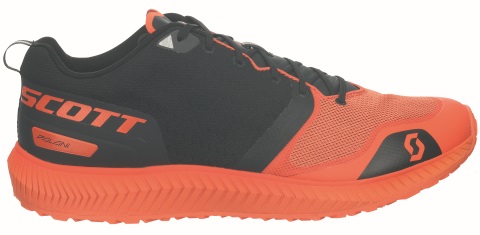
Overview:
The Scott Palani is a new road shoe designed for fast training. It’s an exciting-looking shoe; Scott’s off road heritage shines through and they haven’t followed the standard road shoe design. We like what they have done though, read on to find out more…
The Brand:
Scott launched in 1958 but concentrated on leading design in skiing, cycling and motocross until 2006 when it launched its first running shoe collection. Since then they have pushed development in trail and road shoes and produced a good line of running clothing. They sponsor a team of pro athletes including Andy Symonds and Jo Meek who get involved with product development.
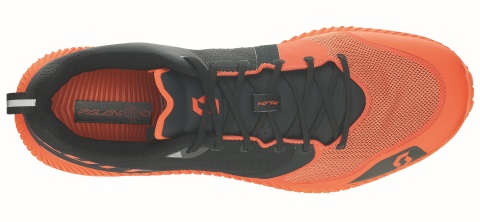
Scott also sponsor some excellent races in the UK:
The Shoes:
This isn’t a super-lightweight race shoe but it certainly isn’t heavy; the materials and construction feel like Scott are pushing the boundaries of road shoe design. The sole in particular looks more like a gravel trail shoe than a road shoe. The striking orange and black colourway looks awesome but it is also available in a more discreet black and white version.
It’s the second lightest model in the Palani range, which includes the Palani RC - a lightweight racer; the Palani SPT - a support version; and the Palani Trainer with more cushioning, designed for higher mileage. Scott produce a women’s version of all of these.
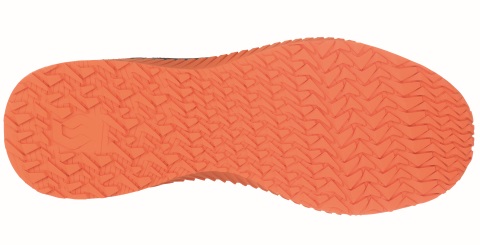
The Fit:
I’m normally a UK11 in running shoes but I’m a UK10.5 in the Palani, so length-wise they’re quite generous. The width and depth is fairly standard and therefore the fit is good for me. The heel cup is deep enough to hold my heel very well and the lacing adjusts the whole upper, making for a great fit.
The Tread:
The shoe features a single piece outsole with a low-profile tread pattern. The tread wouldn’t be out of place on a light weight trail shoe but they offer good grip on the road and after several hundred miles are wearing very well. The tread also means that although they are designed as a road shoe they work very well on dry trails, forest roads and tow paths.
The Sole Unit:
The single piece AEROFOAM INFINITY midsole material provides a neutral and lightly-cushioned sole unit. It’s designed to offer a smooth heel to toe ride. Out running the Palanis don’t feel like they try to influence my running gait; they protect my feet and offer some traction, which is exactly what I want from a road shoe. The 11mm drop from heel to toe is fairly standard for a road shoe and feels good in use.
The insole has some arch support and extra cushioning improving the comfort of the shoe.
The Upper:
The stylish upper is made from a combination of woven and knitted materials to create a seam-free but protective shoe. The toe has a single-piece rubberised guard to offer a bit of extra protection without creating any rub points. Inside, the heel is lightly padded but the forefoot and toe area are almost single layer, meaning they are chafe-free and water drains out quickly.
The thin foam tongue helps keep the upper lightweight especially when wet, but still offers good protection from the lacing.
Verdict:
Once you get past the striking good looks the Scott Palani delivers a simple, well-fitting and technologically advanced road shoe. It’s designed to be a fast-paced training shoe, leaving racing to the lighter-weight Palani RC. We think it would also be an excellent longer distance race shoe for someone who wants a bit more cushioning and protection. I’ve been using it as a high mileage training shoe; it’s responsive but supportive and several hundred miles later I’m still loving it.
Written by Sim Benson www.wildrunning.net for the URC
Price: £115
Weight: 290g per shoe Men’s UK 11 Eu 46.5.
Find out more at www.asics.com
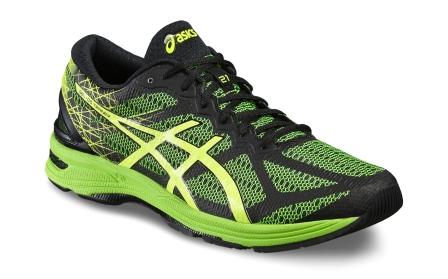
Overview:
The 21st version of the Asics DS-Trainer aims to continue the line of lightweight road shoes. It’s not the lightest shoe in the range but it’s close and claims to be designed for smashing your PB! I enjoy running in a light pair of neutral shoes but I try not to get the lightest racers as I know that light weight can’t be as durable. I’ve used older versions of the DS Trainer before and I liked them so hopefully these will be even better…
The Brand:
Founded in Japan in 1949 but not called Asics until 1977 this is a company dedicated to progressing running shoe technology. Asics continue to innovate using different materials and manufacturing technologies, always trying and create a better shoe.
Ethically Asics publish details of their corporate and social responsibility program which is comprehensive and makes interesting reading. They aim to include social and environmental considerations into all business decisions.
The Shoes:
On first inspection the DS Trainers feel light, the upper is very minimal and, reassuringly for me, the sole has a reasonable amount of cushioning and structure; it actually feels quite stiff. The current men’s version is a green and black design which I think looks a bit like slime but in a good way. The shoe is available in a women’s specific fit and colourway as well but we haven’t tested them.
The Fit:
As I would expect from a lightweight shoe the fit is reasonably slim and the shoe doesn’t have very much volume in the forefoot. This fits me well but if you have wide or deep feet it may not be so comfy. The heel of the shoe is reasonably deep and structured and feels like it should hold my heel well. Length-wise I’d say they are true to size.
The Tread:
Asics have used a soft and grippy rubber around the edge of the fore foot and on the heel and a section of harder studded tread in the middle of the forefoot. The studs don’t feel as grippy as the rubber but they feel like they should be durable and presumably help to make the sole unit lighter. The shoe offers good grip on road and they also feel good on the gravel towpath that I often run on.
The Sole Unit:
The Impact Guidance System that Asics use in most of their running shoes is designed to link the various types of EVA midsole and gel cushioning to create a smooth ride from landing to take off. In practice the shoe feels fairly cushioned and supportive, especially considering its low weight. It feels good to run in, doesn’t interfere with my natural running gait and protects my feet from the impact on the road.
The Upper:
The upper is super light and thin, constructed from a single layer and reinforced with external rubberised banding. Inside the only seams are around the midfoot where the extra heel lining material meets the single layer upper on the forefoot; in use I can’t feel this seam at all. Reading other reviews online I have seen a few comments on the durability of the upper material but after well over 200 miles I haven’t experienced any issues. The tongue is thin but is padded and protects my feet from the standard laces. I do find that I need to be careful not to roll the edge of the tongue up when I put my foot in the shoe, if I do it’s quickly uncomfortable but since I’ve realised that this can happen it’s easy to get right.
Verdict:
The Asics Gel-DS Trainer 21 offers runners a lightweight but I’ve found fairly durable road shoe. The sole is reasonably structured and most of the weight-saving appears to be in the upper, so they still cope well with longer runs and high mileage. They are designed as a lightweight racing shoe and the upper is very light so I wouldn’t expect them to be hugely durable but they are doing well so far and are great to run in. So, assuming they fit you well they would make a great racing and fast training shoe, and I’d happily wear them for longer-distance races.


